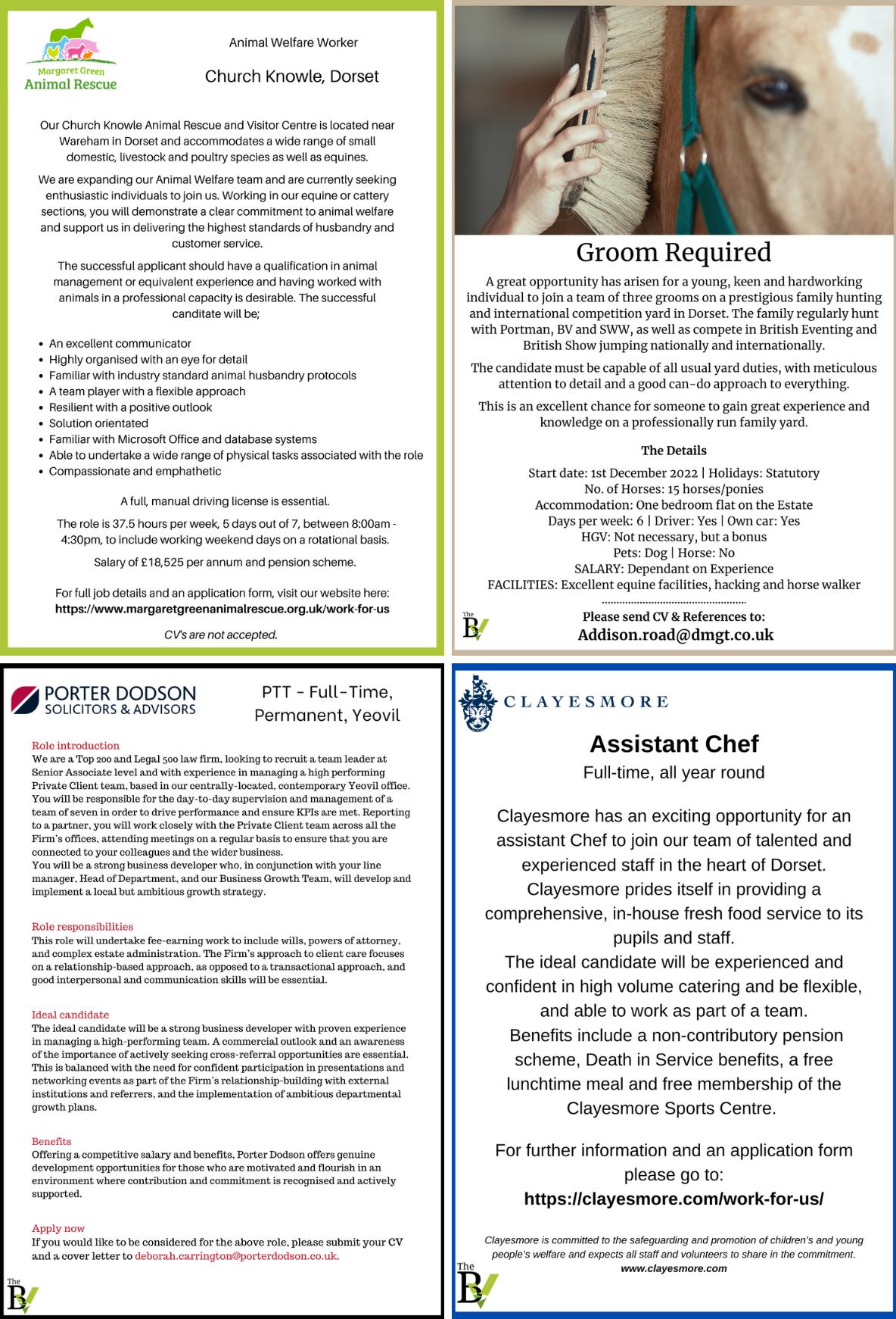From the heart of the Blackmore Vale



Edward Hoare takes on the Random 19
Born at Stourhead, Edward Hoare is a philanthropist and environmentalist who is very fond of Marmite crisps P.16




Born at Stourhead, Edward Hoare is a philanthropist and environmentalist who is very fond of Marmite crisps P.16
As we all struggle to reach our GP for an appointment, NHS Dorset is investing in technology to improve care for the population – sometimes unpopular, it is necessary to cope with demand P.4

If you think your traditional turkey is a dry, underflavoured, over-rated bird, then you might want to change where you buy it, says Rachael Rowe - P.6.
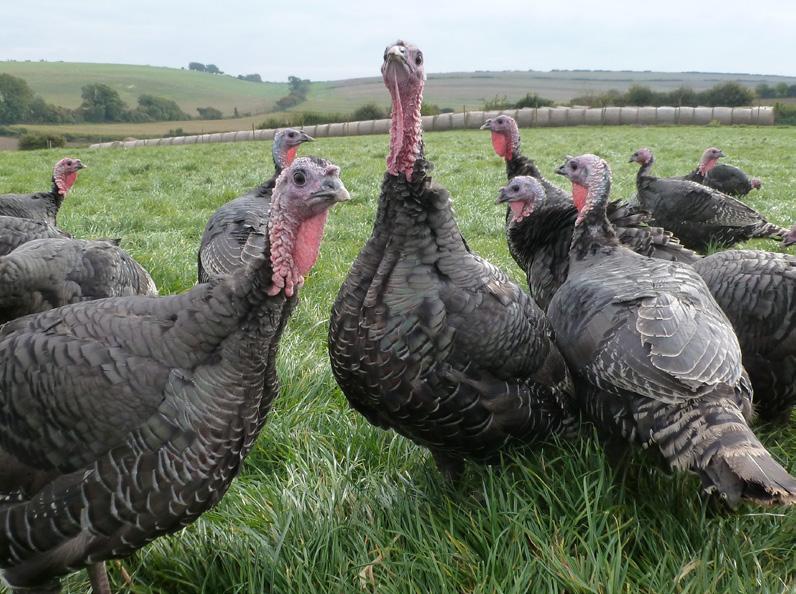
Far from drawing life’s short straw, Master Thatcher Mike Howe switched career to own an artisan business and teach future generations an ancient skill - P.18

This month’s front cover shot of the little owl was taken by Stephen Collins. Image above by Claire Norris. As always, the rest of the Reader’s Photography is a beautiful gallery of local images. P.50
There’ll not be a general election until 2024 – but that doesn’t mean the fight for practical, pragmatic politics ends, argues Simon Hoare MP. Mike Chapman of the LibDems sees spooky insouciance instead of consensus - local politics starts on P.22




y’know,
As I felt the days begin to shorten and cool, I eagerly anticipated a slowing down of the frenetic pace of summer.
And yet September just kept on hammering the blows, didn’t it?
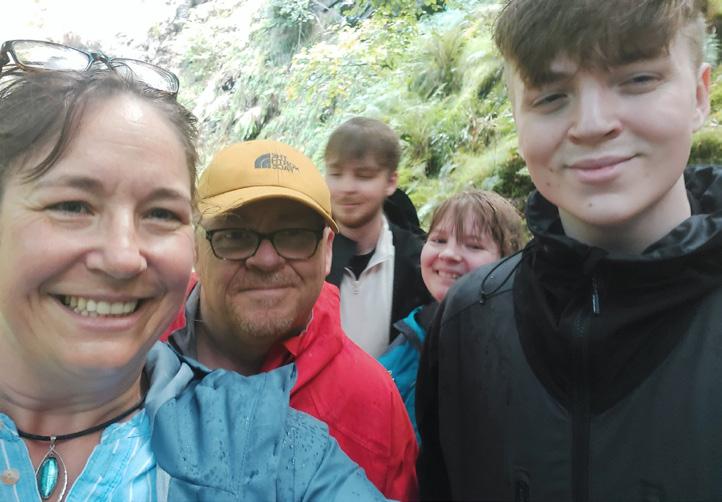
I’m afraid I don’t have insightful words or great clarity to share. Like you, I find myself floundering, baffled and wondering where all the grown ups went who used to be in charge. On the world stage it has been almost impossible to keep up – war in Ukraine, protests in Iran, famine in Somalia, rockets from N. Korea ... I’ll admit there have been spells where I haven’t even wanted to try, feeling despair and despondency shadowing me as I tracked the latest twists and turns in the world’s plots. Here at home Liz Truss and Kwasi Kwarteng have done a magnificent job of keeping things quiet and calm, though, haven’t they? We personally had a rather difficult month. Regular readers will remember our beloved cat Pog, who sauntered into our lives last summer, destroyed our wallpaper and conquered our hearts. At the start of the month she was hit by a car - an ever-present fear for all of us who live on a road. I am aware she was ‘just a cat’. I am aware that in the grand scheme of all the things above, she shouldn’t even rate a mention. And yet. Anyone who has lost a pet will know how we have been grieving, still half-listening for her shouts announcing her arrival as she clatters through the cat flap, still catching sight of her out of the corner of an eye, still missing her warm silky body, so very long and casually slack when lifted, gently rumbling contentedly whenever any of her humans appeared. We miss her deeply. We did finally manage to escape the house, though, and spent a couple of much-needed weeks in North Wales. Not exactly the sunshine-soaked laze by a French pool I had initially planned, but it turned out to be exactly what we all needed – some time away, with each other. Lots of walking, beach combing, castle exploring and evenings laughing over card games. I hope your October is warm, calm and filled with smile-making moments. I think we all need it.

The one and only picture I took all holiday of
five of us
NHS Dorset is investing in technology to improve care for the population –sometimes unpopular, it is necessary to cope with demand. Rachael Rowe reports
Most of us are aware of the increased demands on primary care and hospitals at the moment, and the challenges in getting appointments. But what if there was a way of getting help to people more efficiently, using technology? That’s exactly what is happening with primary care in parts of North Dorset.
The Blackmore Vale Partnership manages GP practices in Shaftesbury, Gillingham, and Sturminster Newton. It has been busy trailblazing a new IT system to manage appointments. Newly appointed clinical digital care co-ordinator Charley Davies explains: ‘Klinik is a nationally recognised system. It is used by 500 practices across the country, and it brings a uniformity to the service.’
As featured in the BV last year, Gillingham Medical Practice, like so many others, adopted a new solution. At that time, Dr Chris Pearce told me: ‘Prior to the new system, Gillingham Surgery received 14,500 phone calls a month. Only 53 per cent of those calls got answered; there simply weren’t enough people to pick up the phone. It’s impossible to deal with that volume.’
Just think about that number for a moment – and that’s just one practice in Dorset. Others have
the same problems – it’s not sustainable.
Who deals with what I recently used eConsult (very successfully) at the Blandford Group of practices and wondered how the two platforms, Klinik and eConsult, differed.
Charley says: ‘Klinik offers so much more, and it also helps with choice and promotes a better service.’
So how is it all going to work when someone phones their GP? Dr Simone Yule, clinical director for the Blackmore Vale Partnership, is clear on the benefits.
‘Klinik will bring a uniformity of service. Whether someone rings the surgery or uses the website, they will get the same response. Part of the problem is the huge range of healthcare practitioners in primary care now, such as paramedics, physiotherapists and nurses.
Knowing who is best to deal with an issue can be difficult. With this new system, we can streamline patients to the right place and for the right reason.
There is an element of instant triage (see video opposite) – and there’s a clinical team behind it looking at what is coming in on the system. So people will either
get a face-to-face or a phone appointment. And it should then be easier to get that face-to-face appointment because the system releases capacity.’

When someone uses the Klinik system, they are asked a series of questions which is a core part of the triage. See the video opposite to watch exactly how it works. It starts with the basics – so, for example, if you have a query about a letter, you’ll go straight to the administrative team.
Klinik is designed to reduce call time, so the issue of being told ‘You are number 52 in the queue’ should resolve. However, the system is not for emergencies. When you have answered the questions, a calendar pops up where you can give a time convenient for someone from the practice to call you or to schedule an appointment. So what happens to the receptionists now?
Laura Grant, operations manager at Blackmore Vale Partnership, reassures me: ’The receptionists are really excited about it. It’s a new system, and it builds relationships with the team.’
Simone adds: ‘We think of receptionists as patient service teams here, because they do
so much more than just be on reception and answer the phone.’
But what if you are unable to use the internet?

Firstly, the phone option is still available; but you’ll still answer all the questions as the patient service team uses the same algorithms to assess your need as the online system.
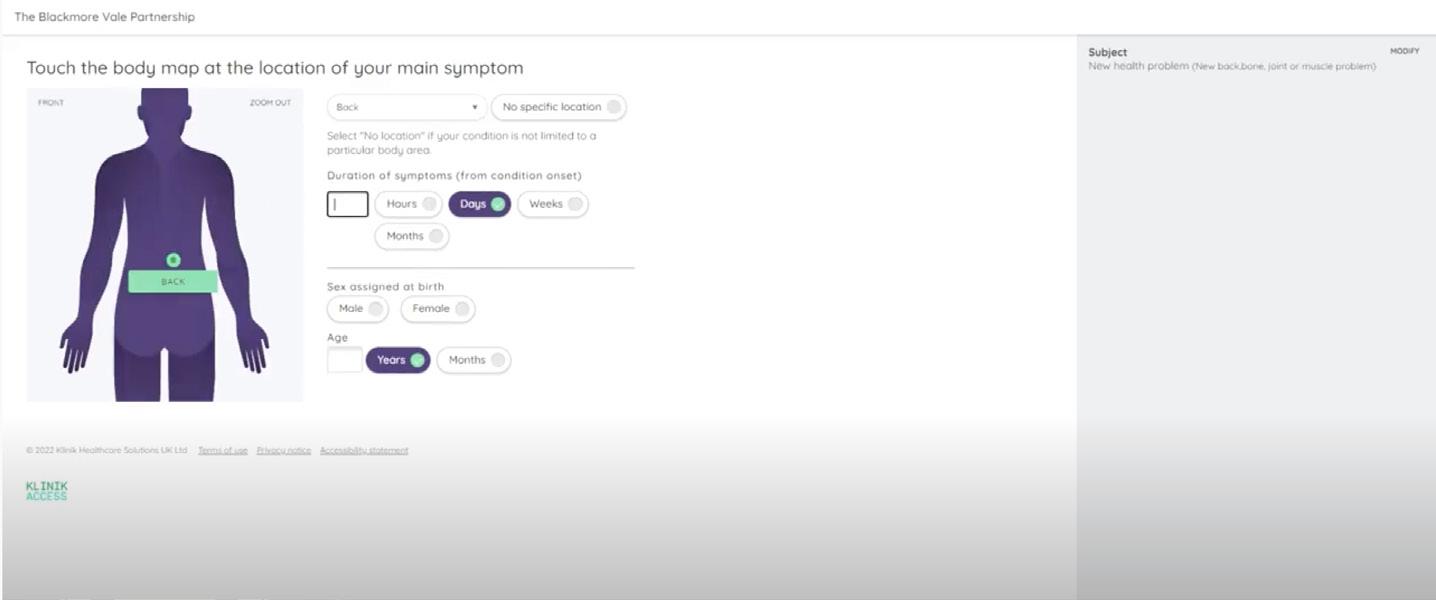
Then they will pass your request to one of the clinicians monitoring the system. And if you want to become more confident in using the online service, Charley is available to help you navigate the internet and use the various apps and technical services best.
More than just your GP Dorset is using more technology to support people managing their long-term conditions and stay healthy. Verena Cooper, who is supporting the project, outlined the MyMHealth app
to me, used by people with diabetes, asthma and COPD. Dorset is also implementing the BP at Home service, where people can measure their blood pressure at home (and usually in a less stressful environment).
In addition, there’s an entire library of online services on the Orcha platform, where all the digital applications have been thoroughly checked for safety and IT security.
Another exciting development in Dorset has been the DIIS (Dorset Information and Intelligence Service – pronounced dice) which uses anonymised data such as
medical codes to help practices and primary care networks identify people who are at risk of developing health problems so they can be targeted for more support.
Whether you like it or not, technology is here to stay in the NHS. From insulin pumps transforming the lives of people with diabetes to robotic surgery and innovative apps which help to manage chronic illness, times are changing.
And the most exciting developments in tech and healthcare are when they make a positive difference to people.

Chilcott turkeys are free ranging Image: Golden Turkeys

If you think your traditional turkey is a dry, under-flavoured, over-rated bird, then you might want to change where you buy it, says Rachael Rowe
It’s that time of year when thoughts turn to plans for the festive season – and the food. For many people, a turkey is the centrepiece of a Christmas dinner. But what goes into rearing the best quality turkey? And how do you know yours will be good? Our local turkey farmers are gearing up for the busiest time of the year and spoke to us about their work.
Alban and Helen Harris are seventhgeneration farmers at Brunsell Farm in Stourton Caundle. ‘I’ve been doing this all my life,’ says Alban, ‘I can remember Grandma on the farm. There’s a lot of heritage with this farm, and lots of things continue here, so the traditional ways of
doing things affect the quality of the turkeys.
‘The turkey industry has been industrialised, and costs have had to be cut. However, we have stuck with our traditional methods. We feed the birds the best quality wheat, soya and cereal. And the whole process is carried out on the farm, so there is less stress to the turkey.’
That’s something that Mark Chilcott of Chilcott Turkeys in Owermoigne also emphasised when talking about quality. He has 30 years experience of producing
turkeys. ‘Everything is done here on the farm from start to finish to monitor quality and reduce stress on the turkeys.
We’re free range, and we have bronze turkeys. When our birds are slaughtered, they are hung whole-bodied so they mature and the flavour improves.’
Alban explained more about the difference between wet plucking and dry plucked turkeys. ‘With wet plucking, the birds are slaughtered and then scalded so the feathers can be removed faster. In mass turkey production, wet plucking can take five seconds to do. However, when you do that, the case is compromised, and the bird has to be refrigerated immediately. Here, after slaughter, all our birds are dry plucked by hand. It is intensive work to pluck a bird manually – usually 20 minutes. So that adds to the cost. We then hang the birds for ten days, so they mature on flavour and tenderise. Turkeys are a game
In mass turkey production, wet plucking can take five seconds ... plucking a bird manually, usually 20 minutes








bird, so they need a chance to mature before they are dressed. This is why some mass-produced turkeys are drier, because the meat hasn’t had a chance to tenderise. Also, most of our birds are hens which put down more fat, and that also adds to the flavour.’
Plumpy Whites and Roly Polys Chicks arrive from June on the farms, and both farmers select from the best strains. The breeds have delightful-sounding names such as Plumpy Whites and Roly Polys (a bronze variety). While the Chilcotts have free ranging birds, Alban’s turkeys are raised in the barns where they have lots of room to stretch their wings and nestle on straw. ‘We’re very wary of risking bird flu by having them outdoors.’
But what about the cost? Both Alban Harris and Mark Chilcott have experienced significant increases in the cost of quality food this year, which will inevitably affect prices. However, a turkey is a large and versatile bird; there is a lot people can do with leftovers to make it more cost-effective. Helen Harris advises: ‘With a fresh turkey, you can freeze the cold meat in portions and use it later in the year.
Soups, curries, and pies are good for using leftovers, and you can freeze them, too. Some people buy a whole turkey from us and cut it in half.
Then they eat half the bird at Christmas and freeze the other side for later in the year.’
Alban and Helen sell turkeys to 17 butchers locally. ‘Julian and Roger Else come here and pick out the turkeys they want.’ Chilcott Turkeys also supply several local butchers and sell at the farm gate.


So what is the customer looking for?
‘People want smaller turkeys,’ says Alban, ‘but are increasingly wanting only breast meat.
‘We need to be realistic on pricing because there is more work in jointing the turkeys. And with crowns, you need a bigger bird, so that affects the price.
‘Sometimes we bone roll ours. One year we bone rolled the turkey and had a piece of venison through the middle, which was really lovely.
I don’t advertise it too much because it’s so fiddly and everyone will want them! It’s one of the last things I do before Christmas, mainly for a few friends, and as I’m doing it, I think, “We’re there now. The turkeys have gone, the work is almost done, and it’s Christmas”.’
Breeds have delightful-sounding names such as Plumpy Whites and Roly PolysAlban and Helen Harris provide the best of everything for their barn turkeys Image: Golden Turkeys


After some consultation, the annual Sturminster Newton Cheese Festival went ahead this year. Rachael Rowe reports on the town’s biggest event
Madame Maryline Lecampion’s eyes twinkled as she described the food she had tasted at Sturminster Newton Cheese Festival. She was part of a delegation from the French town of Montebourg, twinned with Sturminster Newton. Today the team were promoting Camembert, Normandy’s bestknown cheese – and taking every opportunity to try food from the other stands. ‘We have been coming here for ten years now, and it is superb.’
Crowds of people swarmed into the two huge tents lined with stalls. The team from Buckshaw Blewe have been making cheese for five or six years from their sheep’s milk. The blue cheese was delicious and attracted attention. Lyburn Cheese
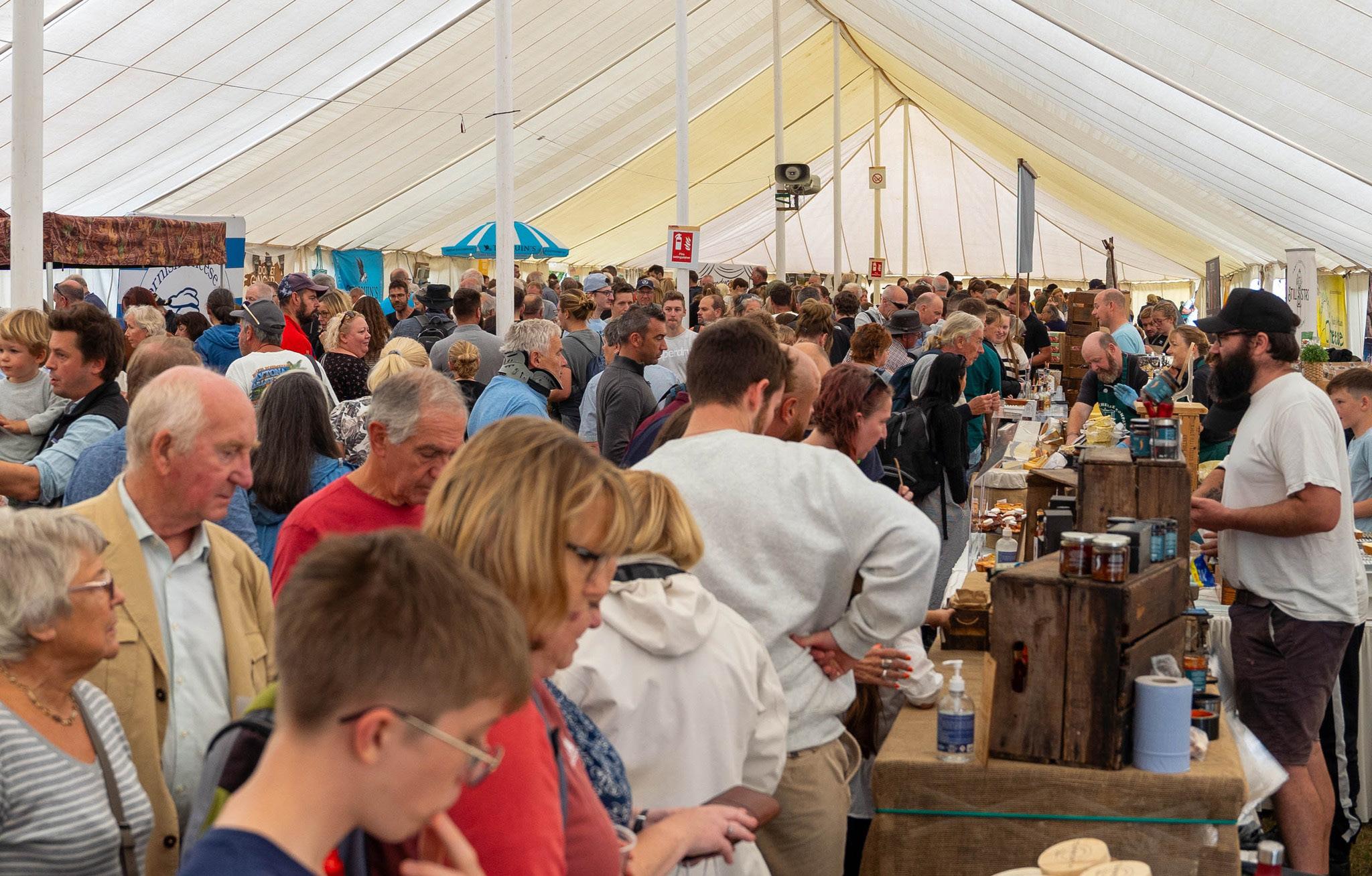
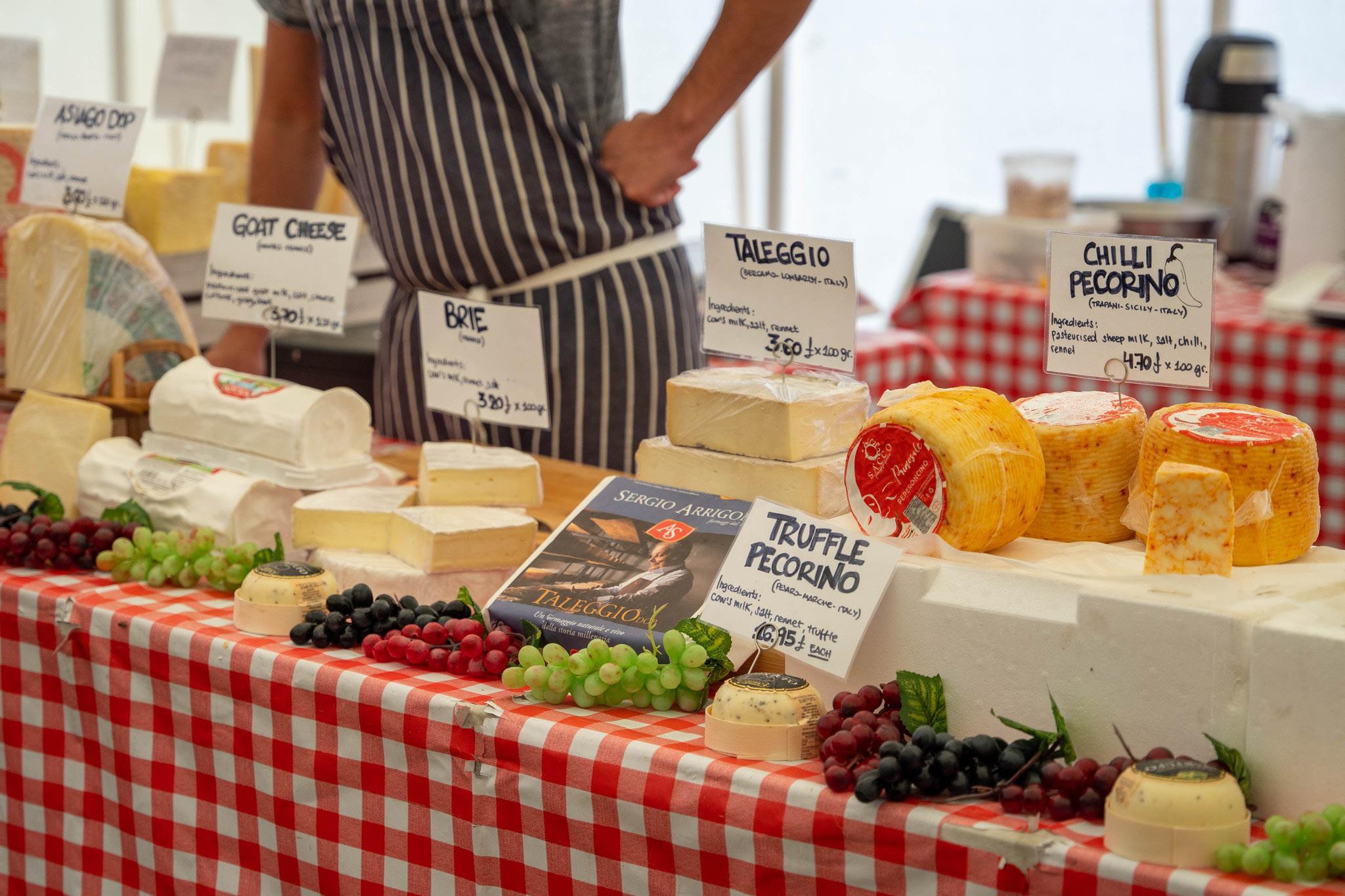
from near Salisbury had an incredibly strong (and delicious) Old Winchester Extra Mature. White Lake Cheese, a Somerset producer, had an excellent range from Driftwood to the interestingly shaped Tor. Some cheese vendors found it hard
to keep up with the demand for samples as people made their way around, tasting new cheeses and seeing a few old favourites.
Some cheese producers had been busy in lockdown, creating
new varieties of cheese. Book and Bucket displayed their entire range, but a new one, Wilde, is seasonal. ‘It’s a cow’s milk cheese with locally foraged wild garlic from Cranborne Chase.’ Feltham’s Farm from Templecombe had two newish kinds of cheese. La Fresca Margarita was created in
And the smell. Not just ripe cheeses, but the warm, heartening smell of a cheese toastie and scents of freshly picked apples
lockdown and is a queso fresco, while the newest cheese, Gert Lush, is a creamy cross between a Camembert and a Saint Marcellin. Wherever you looked, there was the inspiration for a cheeseboard, from Bath Soft Cheese to a Smoke N’ Jack from Padstow Cheese.
People were buying the cheese and tasting; some returned for a favourite and others were influenced by a sample that hit the spot.
And the smell. We’re not just talking ripe cheeses here, but the warm, heartening smell of a cheese toastie from Westcombe Cheddar luring people to its stall and the scent of freshly picked apples from Elwell Fruit Farm.

Annie and Will from Sparkenhoe Farm in Leicestershire brought some of their finest cheeses made from their cows and attracted attention from impressed Dorset buyers. If you

buy Leicester cheese from a supermarket, you should taste their Sparkenhoe Red Leicesterthere’s no comparison. ‘It’s one of the best shows we attend,’ said Annie.


You could interact with producers, find out how they make their cheeses and get a few recommendations and inspiration. There were a series of interesting talks by makers too.
But, of course, cheese needs an accompaniment, and the festival had so much choice here as well. There were charcuterie stalls and sellers with savoury biscuits, cider, and gin (so many different varieties of gin on sale and being tasted!).
But the Sturminster Newton Cheese Festival has so much more than cheese, and showed how integral it is to the community of Sturminster Newton. There were bird boxes galore from Men in Sheds and a fundraising tombola from Vale Pantry. And so many beautiful crafts, from the man patiently weaving a basket to ornate glass
decorations and vibrant knitted hats. There were fairground rides for children and entertainment shows. The committee seemed to have thought of everything. People gathered and sat on hay bales to watch violin and guitar band Ribble entertaining with uplifting music. Families sat chatting, catching up with friends or sampling one of the many food offerings, from Greek souvlaki to Italian pizza. The sun shone on a beautiful autumnal festival, giving people
an opportunity to eat outside and enjoy the atmosphere. They came to find inspiration for regional food and some of the tastiest award-winning cheeses in the Westcountry and beyond. Although this year’s cheese festival coincided with a sad and poignant time for the country, the organisers had decided that the event would continue, and the atmosphere was one of life going on.
For more images, see our facebook gallery here

If – like many homes and businesses across Dorset – you’ve been negatively affected by energy bills rising significantly over the last few months, then keep reading as we bid to save you up to thousands of pounds on your energy bills over time. Sam Hughes, Head of Renewable Energy at The Unique Group has answered some of the most frequently asked questions that they are hearing from their customers as home and business owners look to go ‘off grid’ and switch to renewable energy sources that won’t continue to rise and aren’t harmful to the environment.
Can I get renewable energy in a rural area in Dorset?
Yes, absolutely you can. Rural areas are prime locations for adding renewable products within your home or business. No longer do you have to suffer with power outages and high heating costs by adding solar panels, batteries, and heat pumps. All you need to do is speak to our friendly team of experts who will conduct a survey of your property (which only takes an hour of your time).
This survey allows us to collect a detailed report and we would also need a copy of your latest energy bill for accurate return of investment calculations.
How much will I save by installing solar panels?
This answer is different for every customer – it depends on the size of your property and your budget. However, we can design systems that can drastically reduce your energy bills, often by over half! By also installing an air source heat pump, for example, you have the ability to reduce your heating costs by removing your oil, LPG or gas boiler and adding an energy-efficient system that is proven to reduce your heating costs too.
How much does the average solar panel installation cost a home/business?
Installation costs really do vary depending on the size of the roof or area we can install solar panels on. But a common house installation will start between £5,000 to £7,000 with an associated battery. With the current costs of energy, there

is no better time to look at installing a renewable energy system in your home or business. As well as the potential £5,000 grant provided for by the government, it has now never been cheaper to go off-grid! If you have a larger area of land, installing solar farms will give you the flexibility to host a large number of panels – but of course, they come at a greater cost. We can offer finance packages for businesses; our experienced team is on hand to give the best advice on the best route to becoming independent from the grid network as its stability hangs in the balance.
EXCLUSIVE OFFER for The BV readers, quote ‘BLACKMORE’ for a free virtual consultation with our friendly team of renewable energy experts, and see how much you can save on your energy bills while going green for good. Just call 01202 743231 or email
uniquegroup.co.uk


Edward Hoare is a philanthropist and environmentalist and direct descendant of Sir Richard Hoare, who founded Hoares’ Bank in 1672. C. Hoare & Co. is the UK’s oldest privately-owned bank, retained continuously by the Hoare family for 12 generations, this year celebrating its 350th anniversary. In 1719, ‘Good Henry’ Hoare founded Westminster Hospital, the world’s first publicly funded hospital. In 1891, William Hoare founded the world’s first hospice, Royal Trinity Hospice. Many other hospitals, schools, churches and charitable institutions have sprung from the family’s energetic vision for society. Each year the partners donate up to 10 per cent of the bank’s profits to charity.
Born at Stourhead, Edward was a member of the Hoare’s Bank Family Forum, which continues the Hoare family tradition of giving to good causes. He left home as a young man, living in Rio de Janeiro where he
1. What’s your relationship with the Blackmore Vale (the loose North Dorset area, not us!)?
I’ve always looked out on the Blackmore Vale! Having been born in Stourhead, we’re just a short way away from Bourton, and Bourton is actually within the Vale. So really it has been home for the whole of my life.
Great question! Two slices of toast, a load of grated cheese,
worked in The Bank of London and South America, from 1968-71. He returned home and trained as a Chartered Accountant from 1972 to 1976. In 1977, he embarked on a trip around the world, during which he visited the Royal Chitwan National Park in Nepal, inspiring his pioneering interests in environmental issues. Edward finally joined the family bank as a Bankers’ Agent, a position he held for more than 30 years.
Branston pickle, all put together in a sandwich, the top slice smothered in rapeseed oil. Then put in the top of the oven til it’s really crispy and brown. Delicious!
3. What was the last film you watched?
‘Don’t Look Up’ and YES, I’d certainly recommend it. How important is that film? The fact that the climate complications that we’re looking at now are just the same as those in Don’t
Edward now explores new ways in how to make the planet more sustainable, and has co-created an innovative mind-mapping platform called Thortspace. The main focus of attention is the United Nation’s Sustainable Development Goals (SDGs) and what can be done to enable greater involvement with the most important plans for the planet.

And so, to the questions ...
Look Up, where big business and political thinking get right in the way of what the whole of humanity is facing as a potential catastrophe.
And what’s lovely is that we know the world will have us. If we behave too badly, mother nature will just have us all.
Dogs - I am a dog man ... We have five dogs now - yes, five! One is a weeny little pugchiahuahua cross, and
the others are all smallish labradors.
My very first dog was at Stourhead and was a dachshund called Monty.
5. What shop can you not pass without going in?
Probably connected with food. Especially really excellent food – I’ll go anywhere where there’s exceptional food. I do like Barclays in Wincanton. But I tend not to go to shops. If you go to shops, you get tempted to spend money.
6. What would you like to tell 15-year-old you?
I actually had quite a think about this one, and I think it’s four little things:
1. Do as you would be done by
2. Do things well
3. Take a long term view, and
4. Stand up for right.
(Edward changed his mind on this, his first answer was ‘Listen and listen and listen … and be kind’, which I think is also a great message for a 15 year old - Ed, the mother of a 15 year old)
I’d say looking in the eyes and speaking the truth
8. What book did you read last year that stayed with you?
‘Red Notice’ by Bill Browder (founder and CEO of Hermitage Capital Management, the largest foreign investor in Russia until 2005, when he was denied entry to the country after exposing widespread corruption. In 2009 his lawyer Sergei Magnitsky was murdered
in Russian police custody).
It gives such an insight into stuff that happens – political things, the way the world works.
9. What would you most like to be remembered for?
Trying hard for others, looking to the future and doing it –always.
10. What’s your most annoying trait?
Persistence – I never give up!
11. What was the last gift you gave someone?
the end of it, aged just 22, I wrote the Brazilian rules of life. And even now, 50 years on, they make me smile. And my number one rule is ‘if you don’t ask, you don’t get’ (number eight is ‘Listen – if you don’t, you cannot hear.’)
What’s lovely is that we know the world will have us. If we behave badly, mother nature will just have us all
It was a clothes dryer – and it was much appreciated!
12. Your favourite quote?
In the middle of the Amazon region, with my wife and friends, next to a river ... and it was dream-like.
“If you don’t ask, you don’t get” I went to Eton and at the age of 17, I wanted to learn Portuguese – because Brazil was the first country I knew of where people of all backgrounds and any colour were all living together without threatening violence on each other. I thought ‘hey ho, I’d like to try that’. So I asked my parents if I could learn Portuguese and they weren’t particularly interested in my reasoning, they said: ‘Yes, get on with it yourself”. So I did. With one other person we approached the school, and they arranged a tutor for us. Then, a year later, with no family, friends or connections living in Brazil I got a job in the Bank of London and South America, and went to live in Rio for three years. It was absolutely fantastic. And come
13. The best crisps flavour? Marmite ones!
14. And the best biscuit for dunking? Always a McVitie’s digestive.
15. Your top three mostvisited websites?
• Most Important Plans
• Philanthropy impact
• Mere Mutters!
(a small cheat as it’s the local Facebook group)
16. Chip shop chips or home baked cake? Can I have chips, please!
17. Tell us about one of the best evenings you’ve had? It was my 60th birthday. I was in the middle of the Amazon region, with my wife and friends and other lovely people, next to a river ... and it was dreamlike.
18. What in life is frankly a mystery to you?
I think it’s how uncaring and non-listening and cruel many of us can be.
19. You have the power to pass one law tomorrow, uncontested. What will you do?
I’d pass a law where all public money and public contracts go to recipients who are transparent, so nothing is ever allowed to be hidden.
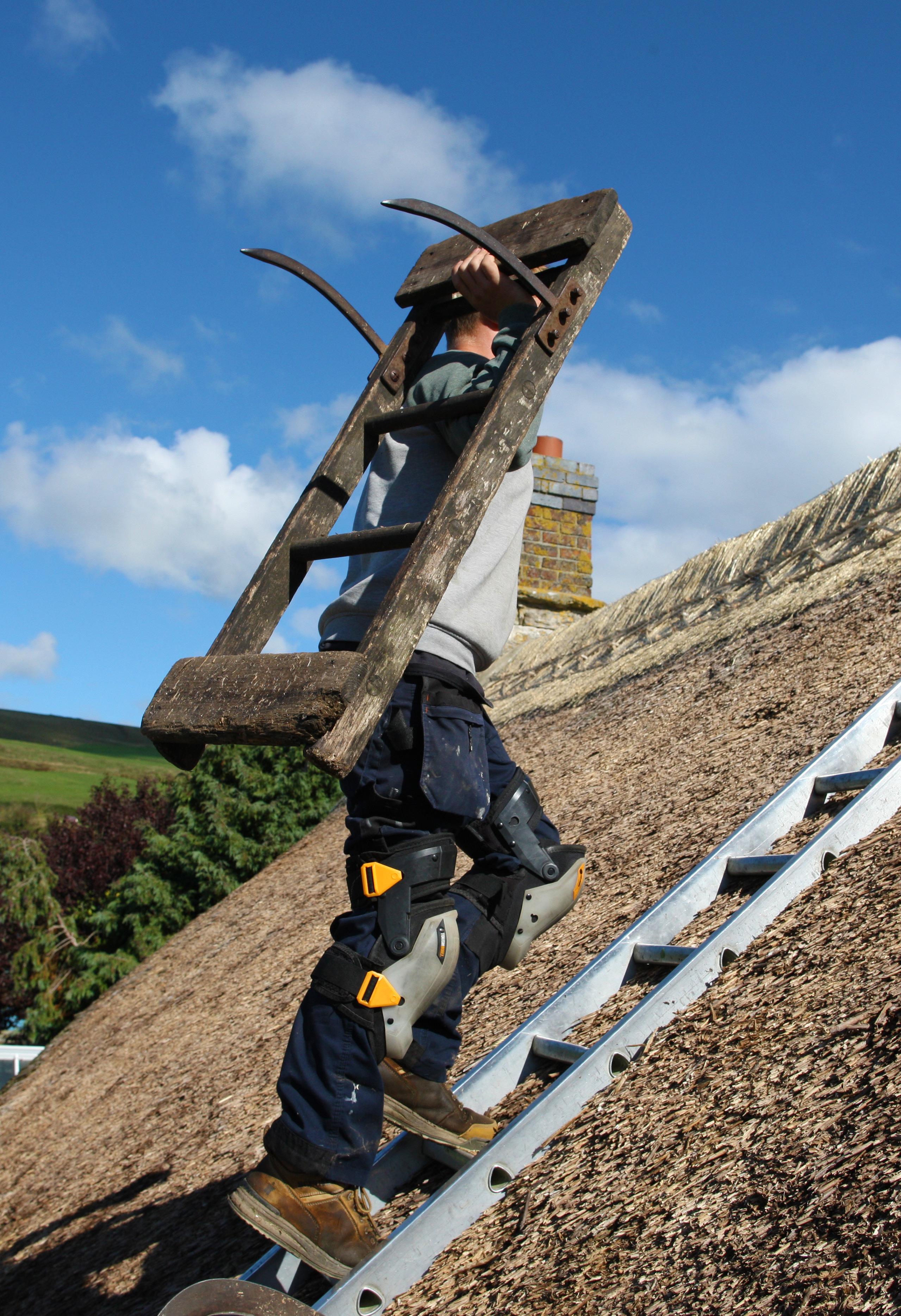
Mike Howe’s ‘office’ this week is a stunning 16th century cottage in the heart of the beautiful village of Abbotsbury. From high on the roof, he has uninterrupted views of rolling hills and the sea beyond. ‘Homeowners often join me on the scaffolding to get a bird’s eye view of the area where they live,’ he says.
Owner of Dorset Master Thatcher, Mike and the twoman team at his Dorset Master

Thatcher business are unlikely ever to be out of work. The county has more thatched properties than any other area in Britain – almost a tenth of all thatched roofs, according to Thatching Info.com. That’s ‘around four for every square Dorsetshire mile’ says the website.

Apprentice thatcher James Hogg loves the work – but is working on his fear of heights.

thatching and working in all extremes of weather – summer’s searing heat meant starting at dawn – Mike believes that ’to have a job where we can be artisans is wonderful.’ He came to this most rural of professions in his mid-30s, having originally trained as an engineer. ‘Being indoors, clocking in and out, wasn’t for me.
I went into farming, working in Wales, Kent and Canada before coming to Dorset. I was herding cows one day and I saw a thatcher on a roof. I thought I wouldn’t mind a go.
‘I wrote letters and finally got a job working for a local thatcher, Glen Holloway.’
Becoming a Master Thatcher takes time. With no formal apprenticeships available, Mike learned on the job. It took him ten years ‘to really get into the groove’ and qualify as a Master Thatcher himself.
To be a member of the
prestigious Master Thatchers’ Association, thatching skills are regularly assessed to ensure all work is completed to the highest standard of craftsmanship. Being a Master Thatcher is the kitemark of good workmanship.

Mike says: ‘With a career shift like this in my late 30s, people were concerned that I wouldn’t cut it. I proved them wrong and here we are now!’
Mike took over the business from his mentor, Glen, and now
employs two young men. Like Mike, Rohan Hennessy knew engineering was not for him. An outdoor occupation was calling and he began working with Mike nine years ago. Now 29, he too is a proud Master Thatcher.
Rohan deftly shows me how he uses a traditional twisting spar – a piece of wood with two sharp pointed ends used to staple a layer of straw into the
Mike, James and Rohan on the Abbotsbury roof they had just finished
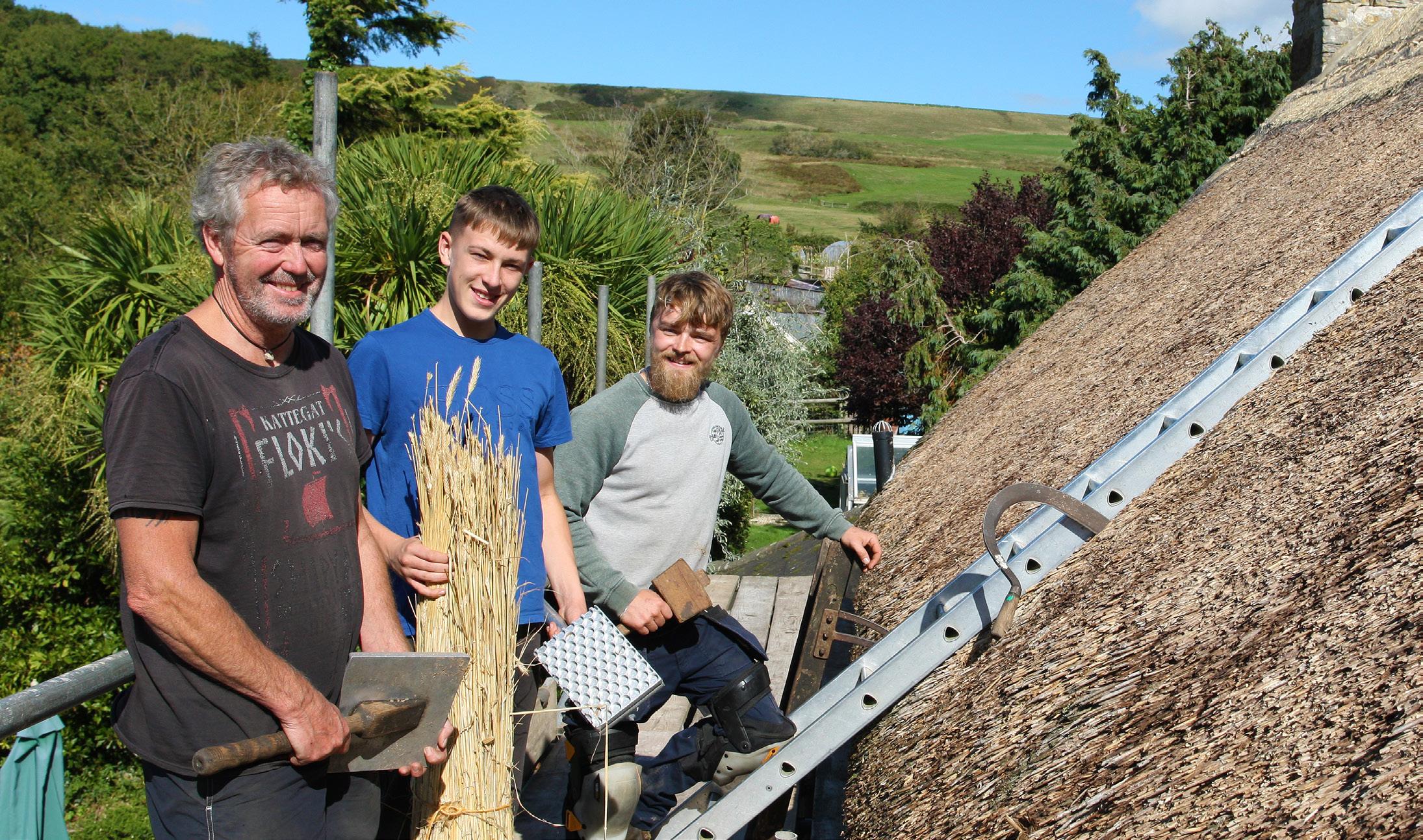
roof. He tells me: ‘There’s so many techniques when it comes to thatching, you never stop learning. It’s really rewarding to see a thatch you’ve worked on still looking great many years later. The longevity makes all the effort worthwhile.’
The huge variety of techniques are one reason it takes so long to gain Master Thatcher status – you can only be assessed for a skill when you have actually worked on that particular kind of roof.
James Hogg was just 15 when he started working for Mike, raking up straw. Now he is doing a bricklaying apprenticeship – there are still no thatching apprenticeships in Dorset colleges – and working with Mike and Rohan two days a week. He says: ‘I love working with my hands. Rohan and Mike are really great to work with too. I’m a bit scared of heights, which is a challenge! But I’m gradually getting more confident.’
The history of thatching goes back thousands of years and Mike is determined that the ageold skills should continue.

‘It’s important to have new generations learning these traditional skills and continuing historic crafts.
‘If we take a roof apart and there’s some spectacular work underneath it from craftsmen gone before us, we document it. It’s a brilliant teaching tool for James.’ says Mike.
Artistic flair really kicks in when it comes to creating rooftop creatures originally used as the thatcher’s mark, an advertisement for who did the work. ‘We love creating signature finials for customers. You can
buy them, but we make our own. We’ve made swans, cats, dogs, even a huge dinosaur for a cottage on the Jurassic coastline.’ Mike and his young thatchers also preserve aspects of modern life: ‘We get asked to put time capsules in a thatch, which will sit tight for 50 years or more. It’s a real honour to know our craftsmanship is bringing past and present together under one roof.’
What book are you reading?
The Whalebone Theatre by Joanna Quinn. The author is the daughter of a customer I did a thatch for. You learn all sorts of things from the people you work for and meet some fascinating characters.
Our new King – you hear so much negative press about him. I’d love to meet the real person. He could also leave his car and butler with me.
Jack Hargreaves – what an advocate for rural occupations. Barry Sheen – for Rohan as he’s a motorbike fanatic!
A thatcher’s tools haven’t changed for centuries


There’ll not be a general election until 2024 – but that doesn’t mean the fight for practical, pragmatic politics ends, argues Simon Hoare MP

The Old Testament book of Ecclesiastes tells us: “To everything there is a season, and a time to every purpose under the heaven.” As the hand of autumn firmly settles over our landscape, we are more than aware of the ending of one season and a passing to the next. And so, perhaps, we might be seeing this on our political landscape too. I fought my first Parliamentary election in 1997. Not a great year for the Tory party and an election that heralded 13 years of Labour Government. Slowly the Tory Party, in the words of the song, got itself up, dusted itself off and started all over again. We should expect a General Election in 2024; I know that many want that to be earlier. I can understand their argument but I do not share it. With all of the recent turmoil and sadness, COVID, Ukraine, the death of The Queen, interest rates and inflation, I really do not believe that it would be in the interests of the UK to take six weeks for a General Election campaign.
I am firmly of the view that most people want the Government to focus – and focus on solving today’s problems in a practical and pragmatic way. I will work tirelessly, as I have done since first elected, to ensure that the interests of North Dorset are taken into account when policy evolves. I want to make sure that Government is doing all it can to help and support people
locally. In so doing, I appreciate that sometimes puts me out of step with Government –but I have usually found that the commonsense side of the argument, that I am inclined to be on, usually wins through in the end. Let me give you some recent examples. I have made clear, both publicly and privately, that I will not support
It is the dragon of inflation that must be slayed, not our pledge to protect the vulnerable
a resurrection of fracking. I will continue with this campaign and hope that Government listens. Fracking is bad news for Dorset’s environment. I hope Government listens to the public mood. Likewise, I could not fathom any economic, social or political merit in removing the 45p income tax band. The
Government listened to many voices making the same point and has changed direction. I welcome that.
I have also made clear that I believe that benefits across the board should rise with the rate of inflation this year. You cannot build a successful economy by making the lives of some of the most vulnerable in society more difficult. It is the dragon of inflation that must be slayed, not our pledge to protect the vulnerable of our country.
During the summer I made clear that helping households with fuel bills was not a ‘handout’ but a vital measure of support due to unforeseen and arguably unforeseeable
events. I therefore welcome the package of measures that the Government has announced for both domestic and business customers. I continue to advocate for a Windfall Tax (as, incidentally, does Shell).
As a Conservative I of course welcome competitive and realistic levels of tax (both personal and corporate). Reducing the tax burden is important and is a noble enterprise, but it should only be delivered when it is affordable. I remain distinctly uncomfortable with the strategy of borrowing to fund tax cuts, and wait to see what the Office for Budget Responsibility has to say on that matter before the Treasury
proceeds. I remain implacably opposed to delivering tax cuts funded by reducing investment in vital public services that the vast vast majority of our fellow citizens use, be it local government, health or education.

High quality public services produce results which play a key role in levelling up. Being poorly educated, feeling unsafe or being unhealthy does not economy contributors make. So, whatever the season, I shall continue, to the best of my abilities, to advocate for North Dorset in the ‘corridors of power’.
To try to secure the best deal I can for you.
I share Churchill’s old view (not one shared by any party’s Whips’ Office) that it’s constituency, country then party that should dictate and shape an MP’s action.
Being poorly educated, feeling unsafe or being unhealthy does not economy contributors make.
Two years ago we enjoyed our best hazelnut harvest ever, with hundreds of nuts to enjoy through Christmas. Last year was very different, with just a handful left. The culprit appeared this summer; a squirrel digging furiously in the garden and every now and then emerging triumphantly with a hazelnut. I was a bit miffed. But we need to share our harvest with other creatures and I appreciated the hazelnut saplings that sprang up where the squirrel had missed some of its buried treasure.
This summer’s harvest is looking very different, though. In the heat and drought our hazelnut tree lost half its leaves mid summer, and then the nuts began to drop. They were empty. Nothing for us, or the squirrel.
On the nearby Alners Gorse butterfly reserve the wild blackberries are small and dry, the sloes are tiny, and the elderberries are almost non existent. Slim pickings for those who like to forage treats from nature’s bounty, but we can buy food elsewhere. Some wildlife will undoubtedly fail to survive this winter for lack of food. The UK is rated as one of the most nature-deprived countries in the world, largely due to intensive industrialised farming. Since 1950 we have lost 118,000 miles of hedgerow habitat, and 97% of wildflower meadows. Unsustainable use of artificial fertilizers & pesticides is destroying our soils, polluting our waters, and crashing the insect populations that pollinate our crops. Of course, these
devastating environmental costs are never included in the price of the supermarket’s cheap food. We as consumers are not powerless. What we choose to buy – and not to buy – makes a real difference. We can choose to eat more seasonal and less highly processed food. And, those who can, to support organic producers whenever possible. Do spare a thought for the wildlife that will inevitably struggle during this post-drought winter. Put food out for the birds, and perhaps let some of your garden grow wild to provide a habitat for the insects and other creatures that life depends on. Perhaps join the River of Flowers project and grow pollinator friendly wildflowers, or join groups working to restore our wildlife. You have the power!
Infighting and infantile economics set the table for a fairly disastrous first course from our new prime minister, says Labour’s Pat Osborne
Few can deny that it was a disastrous first Conservative Party Conference for Liz Truss. Her tax cut U-turn has been a total humiliation for the new prime minister and her chancellor, Kwasi Kwarteng, prompting an infighting freefor-all amongst the Tories, reminiscent of the bunfight scene from Bugsy Malone. But it’s hard to find any amusement in a political piein-the-face when it’s rooted in a collective blunder that will continue to do so much damage to those who can least afford it.
According to the Resolution Foundation, despite scrapping the abolition of the 45p tax rate, the measures announced in the now-infamous ‘mini-
budget’ will deliberately widen the inequality gap further. The richest five per cent will gain an average of £3,500 next year, while the poorest 20 per cent of households will gain around £90. In fact, the richest five per cent still stand to gain more than the poorest half of the income distribution combined, with any real term benefit for most of us being swallowed up by the spiralling cost of living crisis made worse by rocketing interest rates driven by the Government’s economic incompetence.
While Truss and Kwarteng’s £18 billion corporation tax cut remains standing, the Chancellor
has announced £18 billion in cuts to our already creaking public services.
Meanwhile, our schools and our hospitals require intensive care themselves, after 12 years of Tory austerity – and the hardworking people who work in them (and whom we clapped during lockdown) desperately deserve a pay rise, not another real term pay cut.
But as most of us are finding it more and more difficult to make ends meet, Liz Truss’s instinct is to stand firmly by a mini-budget which is designed to line the pockets of the rich and wealthy, and has all the substance of a GCSE economics assignment copied from the Chuckle Brothers on the bus to school.
The squirrel in your back garden really can benefit from where you choose to spend your weekly shop, says North Dorset Green Party’s Ken Huggins
The national picture feels like the beginning of the end, says North Dorset Lib Dems’ Mike Chapman, but there’s need to watch the new Investment Zone
After all the flourish and noisy braying in past weeks from the Government benches about ‘real Conservative policy’ … it all looks a bit less professional today. There are two fundamental concerns here: does this package deliver growth or does it merely deliver division? Then, does this package presage a confident, capable government for the next two years? I do try to be positive, but look, it is desperately simple: those earning the least keep less because personal allowances are frozen. And the mood music says that benefits will be pared back. Otherwise, as individuals or businesses, we are back to where we were a few months ago, except that … interest rates are rising, impacting mortgages; the weak pound and higher cost of imports are stoking inflation; and energy bills will still be going up. I cannot see how these measures in these circumstances deliver an incentive to spend and/or invest – the drivers of growth.
The huge cost has been loaded onto the nation’s credit card in a budget lacking the other side of the equation but it was the insouciance, the devil-may-care
attitude as much as the fiscal irresponsibility that spooked the markets. Added to this, we have the continuing and spreading industrial unrest and anxiety about budgets in every other area of public expenditure. Great start? It feels more like the beginning of the end.
Closer to home, we have Dorset Council looking to turn parts of the county into an Investment Zone, with all the regulatory relaxation that implies.

To suggest that some of the motivation might be to help dig themselves out of the hole they are in with the Local Plan might be unkind. We shall all need to watch, though, how the Zone idea develops; especially when seen in conjunction with the mooted relaxation of the planning system. With Dorset and Somerset both involved, there must also be a danger of a race to the bottom as each competes to attract bigger business investment.
Our democracy, so deeply attached to its polarities and its confrontational ways, struggles
to find consensus of the kind many of the more successful nations seem to manage. Risky shifts in policy, ignoring the experts, have rarely served us well. Consensus may be hard to achieve but it is the soundest basis for public policy.
Enough philosophy. Back to our local world. There are exciting prospects for Sturminster Newton’s ‘Nexus’ business incubator project, whose launch happens on the evening of 10th October upstairs in The Emporium. It brings together many parts of the community, including local business organisations, philanthropists and volunteers, to create a mentoring environment for startups and fledgling businesses. Backed up by seasoned professional advice and support, including the potential for investment, it looks to be an excellent example of what can be achieved by working together toward a highest common denominator.
Three words that trump any race to the bottom, methinks.
Production The invitations have been delivered, the party games are ready, the table is set and the balloons are up. But where are all the children?
Ahead of their 60th anniversary, the Original Three Degrees return to wow us with their soulful voices, beautiful gowns and fabulous stage show.
A 7-piece live band full of incredible singers and musicians. Featuring classic rock songs, amazing lighting and sound. The No 1 UK Touring rock show


Featuring Paul Young, Drew Barfield, Mark Pinder, Steve Greetham, Jamie Moses and Melvin Duffy. This is a Tequila fuelled Tex Mex party night

Enjoy some of the greatest arias and ensembles from the operas of Mozart, Rossini, Verdi, Puccini, and Gilbert & Sullivan. Starring the baritone Philip Blake Jones. Fundraising evenings for The Vale Pantry and The Exchange

The Gurkha Welfare Trust is delighted to bring the worldrenowned Band of the Brigade of Gurkhas to the City for a concert on Friday 21st October.
The Gurkhas are soldiers from Nepal who are recruited into the British Army (or the Indian Army), and for the last 200 years have committed themselves to the service of the British Crown. With previous Gurkha Band concerts being described as ‘a night at the proms - Gurkha style!’, the evening looks set to be an epic one. The performance will include a lively mix of Western and Nepali music, a selection of rousing military tunes, and feature the famous Kukri Dance.
Events and Community Coordinator Keta Hunt says: ’I am so excited to bring such a unique band here for what promises to be a fantastic event. What’s more, the proceeds raised will
all go towards our vital work supporting veterans and their families in Nepal.
Although we’re known UK-wide and have a presence of over 500 staff in Nepal itself, not many people realise that our headquarters are actually in Salisbury. It feels really special to bring the Gurkha Band to our
“hometown”. We hope as many people as possible will come out to this one-night-only event.”
The concert will be at St Paul’s Church, Fisherton St on Friday 21st October and tickets start from just £15, available via the Trust’s website gwt.org.uk.


Carve out some time for some Halloween fun at Teddy 20s Halloween Party on Sunday 23rd October at Durweston Village Hall from 6-8pm. Boooogie on down with our

DJ on the dance floor or throw your best moves when we play musical games!
Don’t forget to look fa-boo-lous in your costume because we’ve got prizes for best dressed.
Cost is £6 per child – limited spaces available so get your tickets quick! Snacks and drinks available on the night.

Contact sophieferry@teddy20.org for tickets.

A nation is in turmoil. Three first cousins – Richard, Aumerle and Henry – battle for the supreme position of authority. Who will succeed in saving their country from a trail of ultimate destruction? And who will survive the challenge for the throne? Tangle, in association with MAST Mayflower Studios, presents a radical and electrifying new adaptation
of William Shakespeare’s ‘Richard The Second’ performed in its distinctive Southern African Township theatre style.

Tangle’s unique interpretation of one of the most compelling of Shakespeare’s history plays, exploring the politics of power and family alliances, will be performed by a multi-skilled ensemble of five. With an original score of Zimbabwean music and song, this new multicultural production offers a fast, powerful and fresh take on this state of the nation play, while celebrating talented artists whose multinational voices are at the centre of Tangle’s work.
‘Richard The Second’ continues the company’s longterm commitment to championing African Caribbean artistic excellence, presenting classic plays in new and surprising ways to audiences of all kinds.
Continuing Tangle’s ambition to perform classic plays in new and surprising ways to audiences of all kinds, the play has been adapted for a multi-skilled ensemble of five actors, with three actors playing multiple characters across the show.
Aumerle will be played by South African actor and director Lebogang Fisher, while Richard will be portrayed by 2021 LAMDA graduate Daniel Rock, in his professional stage debut.
Sharing the roles of Henry & Scroop is Antiguan-born actor Raheim Menzies; Mowbray, York, Gardener will be played by the Eswatini/South African veteran Sibusiso Mamba; and Gaunt, Northumberland and Gardener, by Courtney Winston.
Suitable 12+ | 120mins inc. interval Wed 2 November
Gillingham School Theatre, Dorset artsreach.co.uk | 01747 213 203
Lighthouse, Poole Fri 4 November lighthousepoole.co.uk | 01202 280 000






























































































The Millers have farmed at Longclose for almost 80 years, but pumpkins were only introduced in 2020.
Since then, the truly rural pumpkin picking experience has become an annual fixture in many local family’s October calendar.
The farm’s lockdown diversification project has been such a success that this year the Millers have decided to grow even more varieties! This year the decorative displays will be bigger and better, including the ever popular ‘Munchkin Patch’ – with mini pumpkins that children love! As well as the pumpkins, other attractions include a Craft Fair (15th and 16th October only), a display of modern and vintage tractors, plus the farm animal area. ‘Dorset Lamb’ will be returning to sell hot food and drinks every day, together with a number of other refreshment vendors.
Michael and Vicki Miller run the farm business alongside their sons Quenton and Justin and their daughter Georgina.
The pumpkins have all been individually grown from seed in the farm’s greenhouse and planted in the pumpkin patch without the use of herbicides or pesticides. There is a mix of varieties this year, with differentsized orange and white pumpkins for visitors to choose from.
No booking is required and there is no charge for parking or entry. Pumpkins are priced according to size.
Dorset Country Pumpkins are open from 10am to 4pm on Saturday 15th and Sunday 16th October, then every day during half term Saturday 22nd to Sunday 30th October.

The Festival of the Future is now in its third year, showcasing exciting digital innovations happening across Dorset from 10th to 14th October. Futurefest22:
• ground-breaking digital innovation in farming, education, tourism, health, climate and more.
• discussions about the importance of inclusion, data, skills, and potential careers in the sector.
• listening to the latest thinking and sharing ideas about the possibilities of a digital future.
• exploring what we’ve learnt from the 5G RuralDorset project and how that could be applied to an urban setting.
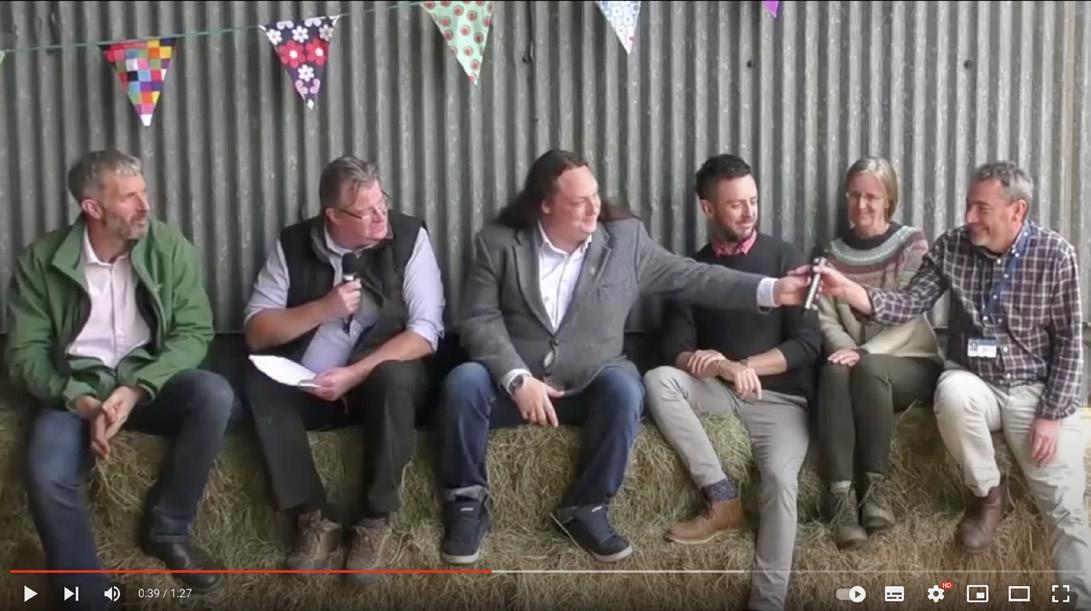
• what a digital town might look like and how we could use technology to solve some of our local challenges, using Weymouth as a setting.
Organisers say ‘We won’t necessarily deliver solutions, and some of these ideas might never take off. But we want to help residents start thinking about the opportunities for digital innovation, using expertise that already exists at the Dorset Innovation Park. This could help make Dorset an even better place to live and work.’
Experience the festival in person and meet the speakers, play with the technology, get practical help and advice and meet other like-minded people. Or if you can’t make the in-person events, choose a virtual ticket to watch the live stream .
Sign up for free on dorsetcouncil.gov.uk/festival-of-the-future-2022





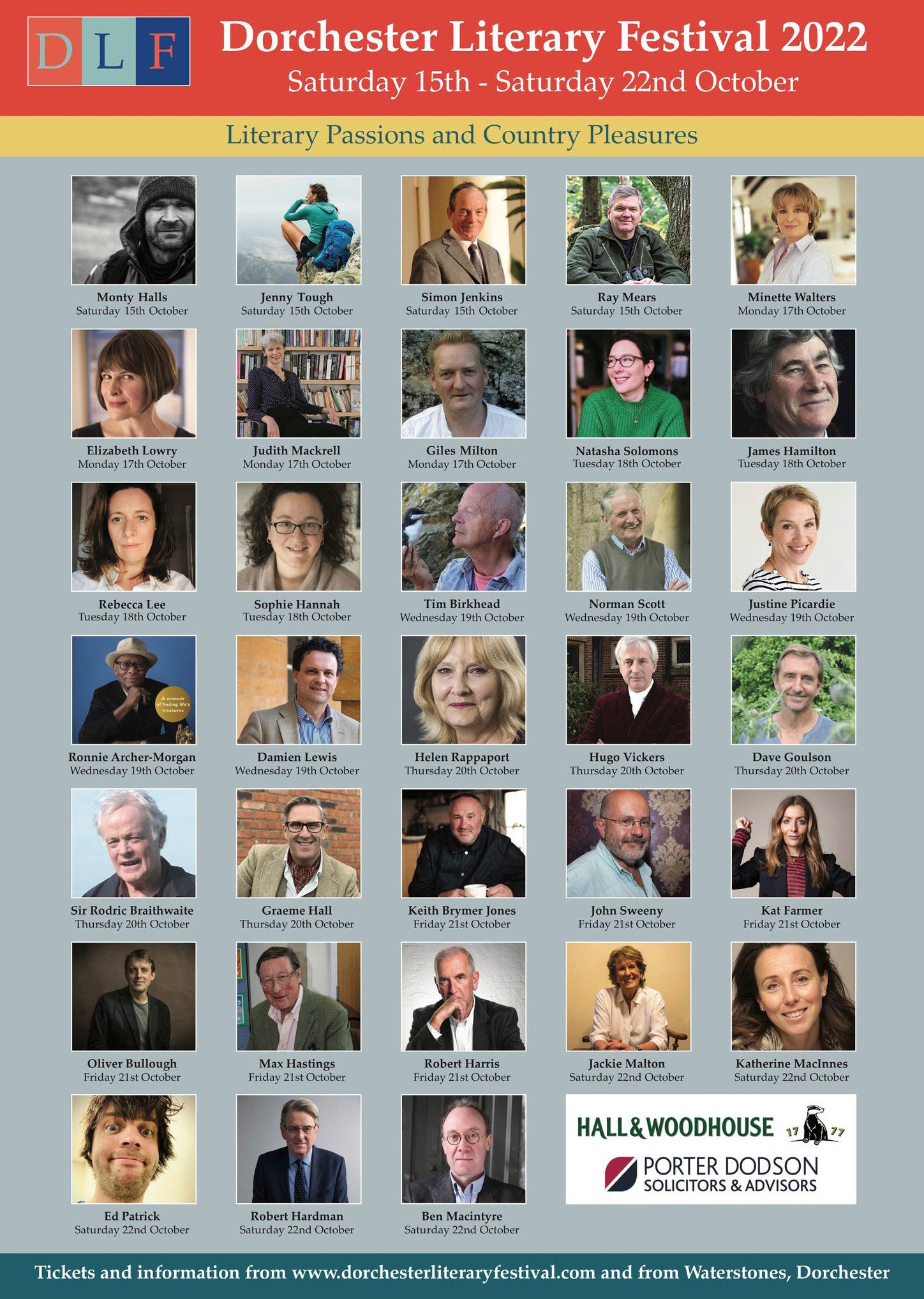





The Green Man c1908 with a line-up of early motor cars. Picture from Roger Guttridge’s Blackmore Vale Camera.
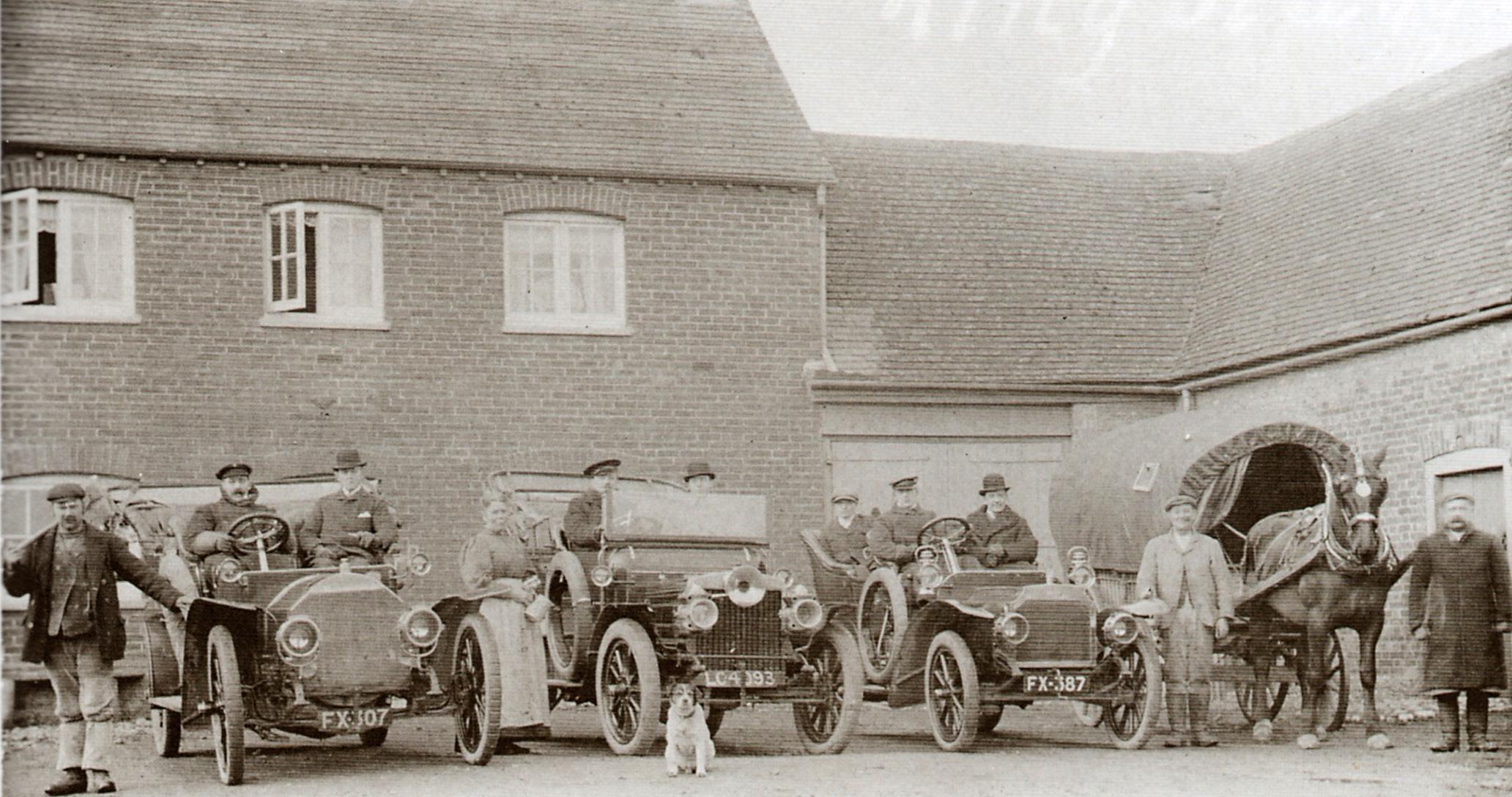
It’s refreshing to find an historic pub that hasn’t had its name meddled with in recent decades, especially when that name is traditional and meaningful. And the Green Man at King’s Stag is just that. According to its website, the hostelry has been in
the village since the 17th century and was originally known as the Inn at King Stag. But it has been the Green Man for as long as anyone alive can remember, and in fact much longer.

I happen to have a copy of Kelly’s Directory of Dorset for 1931 and,
after referring me to the entry for Lydlinch – King’s Stag being in that parish – it told me that the Green Man’s landlord 91 years ago was one Albert Percy Padfield.
The Green Man name is synonymous with forestry and
rural England and a symbol of rebirth, representing the cycle of new growth that begins every spring.
That is especially appropriate right now, given the green shoots that are almost visibly sprouting at the pub.
After what the website itself describes as a ‘rocky few years’, the Green Man is back on its feet with an impressive new beer garden and the additional attraction of a coffee shop. My two pictures from the early 20th century show how little the building itself has changed in more than 100 years.
The one with the three cars appeared in my book Blackmore Vale Camera in 1991, when I was able to identify the owners of those with the Dorset FX number plate.
Far left (FX 307), seated beside his driver in the 60hp Fiat, is Sir Randolf Baker (1879-1953), owner of the Ranston Estate at Shroton and MP for North Dorset.
Sir Randolf, who was twice
awarded the Distinguished Service Order while serving in the Dorset Yeomanry during the First World War, was a motoring pioneer whose first car, a 10hp Panhard, was only the second in the county.
The identity of the car (FX 387) next to the horse and wagon (far right) is in dispute.
In 1991, I had reason to think it belonged to Francis Learworth, of Hanford. But in Lost Dorset: The Villages and Countryside, based on Barry Cuff’s collection of old Dorset postcards, author David Burnett identifies the car as a 16hp Vauxhall owned by Thomas Spiller, of Luccombe Farm at Milton Abbas.
I can’t currently resolve this except to suggest that perhaps it was owned by both gentlemen at different times!
The LC-number plate on the centre car suggests a London registration.
The other early 1900s picture shows a travelling knife-grinder and another local tradesman as well as the usual gaggle of
children who were attracted by the novelty of the camera just as kids today (and some attentionseeking adults!) love to linger in the background when there’s a TV camera about.
There are two stories as to how King’s Stag itself acquired its name.
It was called ‘Kingestake’ in a document dated 1337 while ‘Kingstake Bridg’ is mentioned in the 16th century.
These probably refer to a king’s stake which once marked the spot at the bridge over the River Lydden where the parishes of Lydlinch, Pulham and Hazelbury Bryan meet.
The alternative placename story is much more fun but probably untrue.
Legend has it that King Henry III was hunting in the Blackmore Vale when he saw a white hart, which he decided to spare.

When the king’s bailiff later slew the magnificent beast near the bridge over the Lydden, the king was so angry that he threw the offender in jail and fined the whole Vale.
Hence King’s Stag.
Thomas Hardy’s novels often come with a map of the writer’s Wessex, complete with all his renamed towns and villages.
Far less well-known – but vastly more interesting to me at least – is the rough-and-ready sketchmap of ‘Tess’s Country’ that Hardy drew as he was preparing to write Tess of the d’Urbervilles.
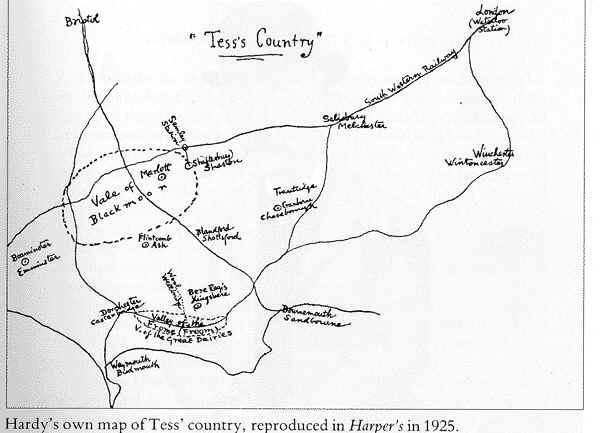
It was published in Harper’s magazine in 1925, three years before Hardy died.
Dorset’s most famous literary son knew North Dorset well, of course, not least because he lived at Riverside, Sturminster Newton, for two years, and wrote The Return of the Native during that period.
The first thing that jumps out at me from the map is the oval-shaped dotted line surrounding the words ‘Vale of Blackmoor’.
Most people today, of course – including the editor of this magazine – spell it ‘Blackmore’, but it’s interesting that Hardy was originally thinking of this alternative version.
By the time Tess was published in 1891, he had adopted a third option, and hedged his bets, writing in the opening sentences of both chapters one and two of the ‘Vale of Blakemore or Blackmoor’.
This suggests that in Hardy’s time or earlier, some people might have pronounced it ‘Blakemore’. The only Blackmore Vale town or village that appears on the map is Marlott, but unlike most of the other locations further afield, Hardy doesn’t
bother to add its real name, Marnhull. Marlott also appears in the novel’s opening sentence as Hardy describes John Durbeyfield’s walk to his home in the village following his weekly visit to the market at Shaston (Shaftesbury), which also appears on the map.
Semley Station on the ‘South Western Railway’, which served Shaftesbury and appears in Jude the Obscure, is one of two stations on the map, the other being London Waterloo.
It’s during his journey home from Shaston that Durbeyfield meets the antiquary Parson Tringham, who sows misplaced ideas of grandeur in his head by calling him ‘Sir John’ and alleging his descent from Sir Pagan d’Urberville, who came over with William the Conqueror.
The suggestion sets in motion a tragic train of events that culminates in the illfated Tess Durbeyfield’s execution at Wintoncester (Winchester).
As elsewhere, Hardy used real buildings in his descriptions of Marlott, including Durbeyfield’s local, Rolliver’s (thought to be based on the Blackmore Vale Inn) and the Pure Drop (the Crown), which according to John offered a ‘very pretty brew’.
Identification of the Durbeyfields’ cottage is more challenging.

A sketch map of Wessex is a priceless companion to Hardy’s masterpiece, Tess of the d’Urbervilles, says Roger GuttridgeThe Pure Drop or Crown Inn at Marnhull aka Marlott
In Thomas Hardy’s Wessex, published in 1913, Herman Lea said ‘the old cottage in which Tess was imagined to have been born’ appeared to have been ‘swept away’. In the introduction, Lea thanked Hardy for correcting a few place identifications.
This is contradicted by later sources, which claim that Hardy identified ‘Tess’s Cottage’ during a visit to Marnhull in later life.
Other places on Hardy’s map include Emminster (Beaminster), home town of Tess’s husband, Angel Clare; Flintcomb-Ash (Plush), which he calls a ‘farm near Nettlecombe Tout’; Shottsford (Blandford); Trantridge (Pentridge), home of the Stoke d’Urbervilles and Tess’s seducer and rapist Alec d’Urberville; nearby Chaseborough (Cranborne), where Tess waits for her friends at the Fleur-deLuce, which in real life has happily regained its traditional name the Fleur de Lys; and Melchester (Salisbury), where Angel and the fugitive Tess pass over ‘town bridge’, based on St Nicholas Bridge, built in 1245.
Dorset Archives Trust (DAT) is leading a fundraising effort to unlock the internationally significant, UNESCO-listed archive of author Thomas Hardy. At present the collection (which consists of more than 150 boxes of material including diaries, photographs, letters, books, architectural plans and poetry), is almost invisible to the wider world. The archive contains such items as the manuscript of The Mayor of Casterbridge, correspondence to Hardy from TE Lawrence and Siegfried Sassoon, and the plans for Max Gate.

Dorset History Centre is keen to unlock this fantastic resource by creating a free online catalogue for all to access.
DHC estimates that it will take around 18 months to complete the task. Once done, Hardy’s archives – the bedrock of any research into the author, his life and work – will be permanently discoverable online. Anyone can then come to the History Centre to view the physical collection. The archive is a true jewel in
To the south of Dorset, Hardy creates a smaller dotted shape enclosing the words ‘Valley of the Frome (Froom)’, which he also calls the ‘Valley of the Great Dairies’, in contrast to the Vale of Blackmoor, which is the ‘Vale of Little Dairies’.
Close to the River Frome are Wellbridge (Woolbridge Manor), which once belonged to the d’Urbervilles and where Tess and Angel stay after their marriage, and the ‘half-dead townlet of Kingsbere’ (Bere Regis), where the similarly named Turbervilles were lords of the manor for 500 years.
Casterbridge (Dorchester) and Budmouth (Weymouth), which commonly feature in Hardy’s work, are also shown, as is Sandbourne (Bournemouth), which in Hardy’s lifetime had grown at breakneck pace to become a ‘fashionable watering-place’.
It’s at Sandbourne that Tess effectively seals her fate by murdering Alec d’Urberville with a carving knife following the unexpected return of her beloved Angel Clare.
Dorset’s heritage crown and deserves to be recognised and celebrated as such. The project will require £60,000, and DAT has started
a crowdfunding campaign in support of this. Anyone wishing to contribute can do so by going to www.dorsetarchivestrust.org or clicking the image above.
Roger welcomes questions and comments - roger.guttridge@btinternet.com
This suggests that in Hardy’s time or earlier, some people might have pronounced it ‘Blakemore’.
Blandford’s church has never had the B’Stards planned steeple – it is finished instead with the wooden cupola which they didn’t get to build. All images: Rupert Hardy
The brothers, William and John B’Stard (schoolchildren … no tittering please) or Bastard, as some call them, owed a lot to a candle-maker whose workshop is now the site of the King’s Arms in Blandford. His apprentice was boiling up some soap, but the fire in the furnace got out of control and within an hour much of the town was alight, the fire fanned by a strong wind. More than 400 families lost their homes on that fateful day in 1731. The abundance of thatched houses in that period contributed greatly to the high incidence of domestic fires. However, the sheer scale of Blandford’s fire meant it was soon designated as a Great Fire, and was considered a national disaster. Charity performances and parish church collections
throughout England helped raise a large sum to start reconstruction.

John and William were surveyor-architects and civic dignitaries in Blandford. Their father Thomas’ workshop was destroyed in the fire, but the fortunes of his sons were made as soon as they were appointed fire assessors.

They were thus in a strong position to benefit from the rebuilding, which was mostly done in a vernacular Baroque style.
The most significant buildings in Blandford today were built by the B’Stard brothers, including the impressive Town Hall and Corn Exchange, the Greyhound Inn and their own splendid house
overlooking the widened and improved Market Place. They also built a terrace of almshouses and private houses such as Coupar House.
The parish church of St Peter and St Paul was designed and built by them between 1732 and 1739. It was originally intended to have a steeple, but funds ran out. The brothers were rather put out when the contract for the wooden cupola was given to a competitor.
Recent cleaning of a portrait of William, now hanging in the Town Hall, revealed that he had curiously been painted sporting a black eye! At first it was thought that the darker patch was simply dirt that had accumulated over the years but further research revealed that it may have related to a dispute over the completion of the church. There is no evidence though to confirm it.

The interior of the church is imposing, with a grand arcade of well-spaced Ionic columns. When visiting, do not miss the Dad’s Army effort to confuse the enemy in the north transept; all references to Blandford in the charity boards there were deleted in 1940!
The church is now acknowledged to be one of the better examples of a classical Georgian church in England, thankfully little altered by the Victorians. Beside the church is a memorial to the Great Fire. It comprises four Doric columns with a stone canopy made of Purbeck stone, also built in the classical style. It was erected over a piped spring
so that fire hoses could be attached, but is now a drinking fountain. A more recent memorial by the Blandford Poetry Group is on a Purbeck paving stone in front of the Town Hall, and reads ”Recipe for regeneration: take one careless tallow chandler and two ingenious Bastards”.

Many are confused by the brothers’ building style. Primarily they designed in a vernacular Baroque style, harking back to Wren and Gibbs, (their capitals reminiscent of Borromini, with volutes turned inwards), but they did not ignore the more austere Palladianism so fashionable at the time. The Town Hall appears to be Palladian, but the ground floor, with its open arcade of three segmented arches, is more typical of Renaissance market halls. If you visit the Mezzanine Room in the B’Stards’ own house (ask at the Age UK shop, 73 East Street, which now occupies part of it) you will see the ornate plasterwork and interior decoration of which they were capable. It was a showroom for clients. Look carefully and you will see that the pediment of the overmantel is Palladian, while the pediment of the door opposite is Baroque.
Unmarried and childless William died in 1766, and John four years later in 1770. Both men were unmarried and without issue. Both are buried in Blandford.
Wild Light - A printmaker’s day and night by Angela Harding (£25)
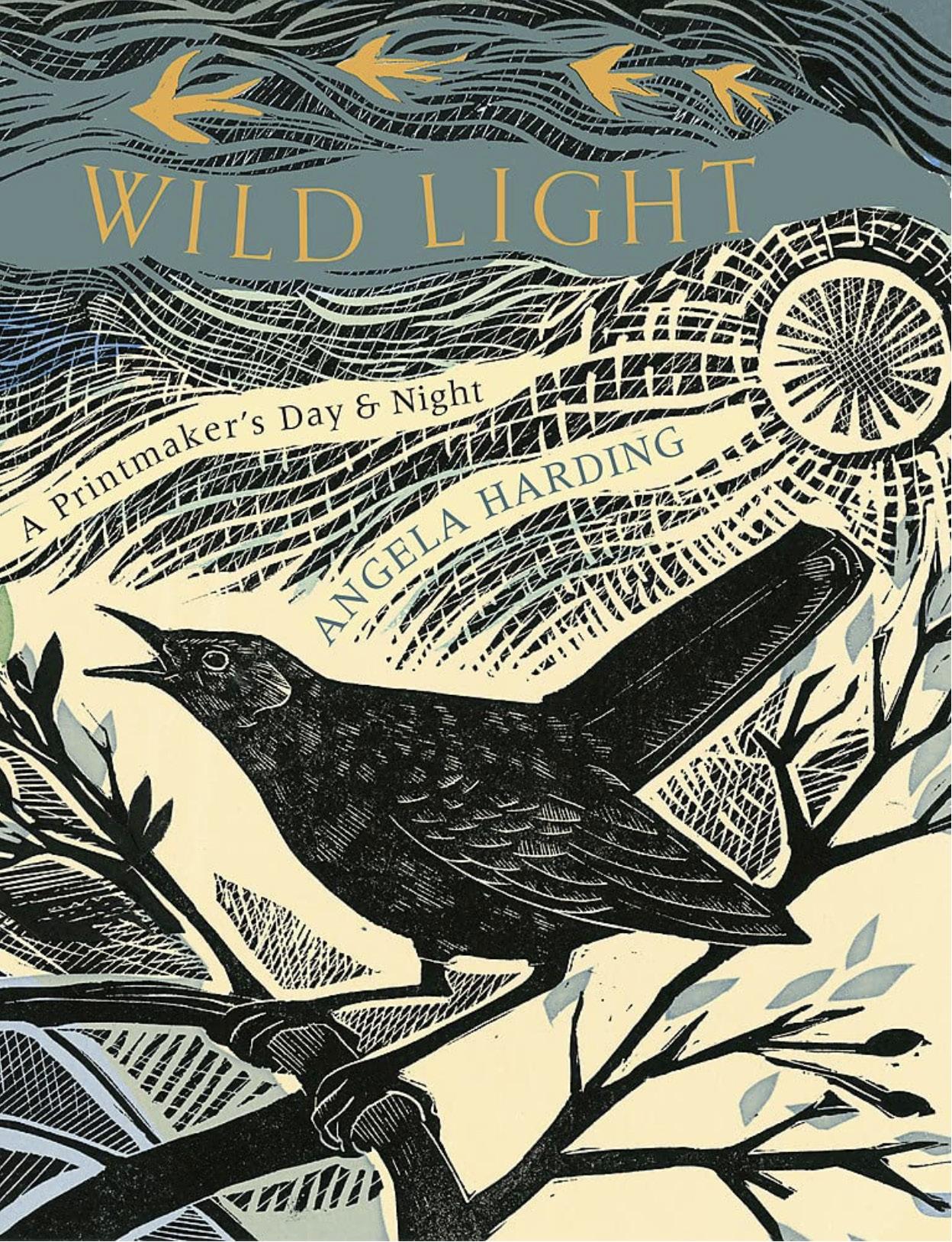
With more than 70 original illustrations, printmaker Angela Harding invites you to look at how the light changes the world around us, and how that, in its turn, changes us.
‘I, like many other people, find great inspiration in the way mornings, evenings or bright midday light changes the way we see the things around us. The bouncing light of a cloud-filled storm sky can change a seascape through a palette of blues, greys, and turquoises. The cool summer moonlight that crosses my back garden sends long shadows that change the mood of the garden from homely to unfamiliar. And whether it’s the low light of an English February afternoon or the sharp, bright mid-morning light of the Cornish seaside, the light and dark we experience affects our moods.
‘But life is busy, and I am as guilty as anyone of being too preoccupied by daily life to just stop and look. This book is a collection of illustrations from those moments when I have stopped and looked; when a particular encounter with nature has been highlighted, becoming a strong image long remembered and one that I wish to illustrate.
‘I hope you enjoy this journey through 24 hours of my collected memories of the nature that surrounds me.’
Angela Harding is a fine art painter and illustrator based in Wing, Rutland. She is inspired by British birds, nature and countryside. Angela is also the book illustrator featured in Raynor Winns’s books, Salt Path, Wild Silence and Landlines.
Join Wayne and the team at Winstone’s for a Talk and signing with Angela Harding on 8th November in The Butterfly Room at Castle Gardens, Sherborne, at 6.30 for 7pm. Tickets, £5, available from Winstone’s Sherborne or online here
In The Seed Detective, Adam Alexander shares his tales of seed hunting and the stories behind many of our everyday vegetables. We learn that the common garden pea was domesticated from three wild species more than 8,500 years ago; that Egyptian priests considered it a crime to even look at a fava bean, that the first carrots originated in Afghanistan (and were purple or red in colour) and that the Romans were fanatical about asparagus. Taking us on a journey that began when we left the life of the hunter-gatherer to become farmers, Adam tells tales of globalisation, political intrigue, colonisation and

serendipity. Exploring the world’s rare and endangered heritage and heirloom vegetables, Adam explains the importance of continuing to grow these varieties and saving their seeds, not only for gardening and culinary pleasure, so that their stories can be passed on to future generations.
Join Adam for a talk and book signing in The Butterfly Room at Castle Gardens. Doors open at 6:30pm and free refreshments will be provided. FREE event - please register online here




An eclectic range awaits you in the As The Crow Flies shop at The Gugg All images: Edwina Baines
John Stanley and Deanne Tremlett give Edwina Baines a tour of the enormous range of creative options available for the whole community at The Gugg in Stalbridge
Gone are the days when the cows were driven up Station Road twice a day to be milked. The yard and outbuildings of the 16th century farm have for more than 25 years been the home of Guggleton Farm Arts – or The Gugg as it is now affectionately called. The farmyard offers an eclectic range of studios, galleries and shops, as well as the Dutch Barn Sculpture Yard and a large space available for outdoor events.
A sign at the entrance proudly announces a Community Interest Company, where anyone can join for art, crafts, textiles, ceramics, printmaking, music, sculpture, film… and tea!’

A little refreshments cabin, crammed with cosy sofas, is tucked into the corner of the Dutch barn. It was here that I
enjoyed a cup of coffee with treasurer and director John Stanley and curator and artistic director Deanne Tremlett.
Guggleton Farm Arts was founded by owner, artist Isabel de Pelet, a renowned champion
of visual and performing arts and supporter of local artists, as an inspirational environment for artistic exploration. It welcomes local people to get involved in creativity of all kinds at all levels. Exhibitions

by established artists inspire visitors and resident and participating artists to develop their aspirations.
At the beginning of 2019 Isabel stepped back from dayto-day involvement. It was a serendipitous search for a new studio that led accomplished painter Deanne to Stalbridge. She has helped in the continuing development of Isabel’s vision ever since, as it is one which entirely mirrors her own. She says: “At the heart of all our work is the belief that any creative pursuit, no matter what form and independent of its outcome, promotes wellbeing, nurtures the mind and provokes discussion and engagement. We are a place for all ages and experience, offering opportunities to become involved in a creative community, with all of the joy and growth that this creates. We’re not looking to be results-based – we’re looking for people to enjoy themselves through their creativity.”
The Shedders I visited on a Tuesday, the day the Men’s Shed was in operation. This is one of 576 sheds in the UK which belong to the Men’s Shed Association. Whatever
the activity, the essence of a Shed is not a building, but the connections and relationships between its members.

These are community spaces for men to pursue practical interests at leisure, to practise skills and enjoy making and mending. David Stubbings, the Shed co-ordinator, was notionally in charge at The Gugg - but I gathered the activities were a collaboration between the other Shedders, as they are called. The space was filled with woodworking and metalworking tools, most of which have been donated or are owned by David.
The activities are similar to those that the Shedders might undertake in their own garden sheds, but with the company and encouragement of others, helping to reduce the common loneliness and isolation. Most importantly, they’re fun, as I saw from the laughter and camaraderie from busy ‘workers.’
Every corner used Our next stop was The Byre, a community flea market and brocante space stocked with lovely bits and bobs and run on a commission basis. John said there had even been visits from

dealers in London who came down to Dorset and grabbed some bargains.
In the Milking Parlour Gallery there was an exhibition of new paintings by Matthew Hayward. John explained that artists are invited to exhibit and the calendar is booked a year ahead. Outside the gallery, tucked into a corner, there is a cupboard full of free craft materials for children, who can go to the Dutch Barn with their parents, to make things, during the holidays.
John showed me the Pottery Shed, recently equipped with a shiny new kiln, where classes will soon be held. Thanks to a grant from Dorset’s Culture and Community Fund, all children within the catchment area can enjoy two free pottery lessons.

Tutor Carolyn Finch Corlett was teaching her weekly Oil Painting from Observation class in the workshop/art room that she describes as ‘an inspiring space.’
In a nearby studio, Jo Winter was using her jigsaw to create some new designs which she will use in forthcoming classes. She is a mosaic artist who works mainly in 3D. She showed me photographs of quirky dog sculptures that she sold in Brighton. They started life as
a wire armature covered in concrete and then were layered with ceramic or lustreware mosaic. Her sculpture Fox Trotsky has pride of place at the door of the craft gallery. She felt a two-
dimensional approach was more appropriate to introduce mosaics in the classroom.
The craft gallery houses one-off items created by local makers and artists living within a 20 mile radius – hence the shop’s name As the Crow Flies. Deanne’s mother, Mary Tremlett, says she enjoys her one day a week volunteering at the shop.
I could have spent hours browsing the wonderful items in stock, including macramé wall hangings and items created by Laura Jackson, who runs classes in air dry clay and découpage as well as macramé. The wonderful stock includes macramé wall hangings and other items made by Laura Jackson, who discovered that macramé was excellent therapy after difficulty with movement and numbness in her fingers following a stroke four

years ago.
Laura, who runs classes in air dry clay and decoupage as well as macramé, says her first attempt at a pot-hanger was a disaster, but she has learned much from her initial mistakes.



Deanne persuaded her to run classes, giving her confidence a further boost. She enjoys sharing the craft with other enthusiasts and everyone leaves the sessions with a piece of macramé, a satisfying outcome.

The Dutch Barn hosts a variety of community events and coffee mornings to help combat isolation, as well as musical soirées of all sorts.
Thursday is Open Mic night, the aim being to help up-andcoming musicians on their road to success. The audience can bring their own drinks or picnics as the venue is not licensed – but popular stone baked sourdough pizzas are available.
There is too much going on at The Gugg to describe all the activities; I left the venue impressed by Deanne’s enthusiasm to create a space where everyone is welcome – even if just as a safe haven to come and sit. She feels that everyone can benefit from some form of creativity – it has been lost from so many lives. She believes in living a more sustainable life and in having the confidence to make a mistake, in finding your own path and your own happiness. Who could argue with that?



 READER’S PHOTOGRAPHY
READER’S PHOTOGRAPHY




Hare’s foot ink cap Tracy Whincup
Folks, I’m back, and I apologise for the few months absence! Life events got in the way, as they invariably do. However, the nights are drawing in, and that means it’s definitely time to get the cover off the scopes!
To celebrate my return, I thought I’d show a new part of the sky that I’ve not imaged until recently.
I do have a habit of going back to old favourites, which is easy to do when you acquire new scopes or cameras (yes, that’s right, more money has been spent – whoops!) so you may see some familiar objects if you’re a long term reader, but I promise they’ll be bigger and better than before!
This month’s image (opposite) is a close up on the eastern part of the Soul Nebula (also known as Westerhout 5), an emission nebula located in the constellation Cassiopeia. It forms part of a famous pair known as the Heart and Soul with the
neighbouring Heart Nebula (IC 1805). The Soul Nebula is sometimes also known as the Embryo Nebula or IC 1848, which is a designation used for the open star cluster within it.
The Soul Nebula is being carved out by the stellar winds from the stars embedded within it, a process that leaves behind large pillars of material pointing inwards. These pillars are very dense and have stars forming at their tips. Each pillar spans about ten light years.
This image was taken using my new Skywatcher
Maksutov Newtonian telescope, the 190-MN DSPro, which is a hybrid imaging scope that provides better image quality than my previous 200PDS Newtonian, which I will miss dearly!
At around six and a half hours of data, you can clearly make out the features that give the nebula its unique name in the night sky.
There have been some great celestial events over the last few months during my absence, but there’s still time to catch some of them if you haven’t already. Most notably, on 26th September Jupiter reached opposition and was closer to Earth than it has been in the past 59 years. There really has never been a better time to grab your binoculars (or telescopes) and take a peek to spot the giant planet and its moons.
This month, we’ll be treated to meteor showers and a partial eclipse. It’s going to be a busy month! On the 8th of October, look out for the moon as it passes under Jupiter, shining very brightly in the sky at the moment due to its close proximity.
On 12th and 14th October, the waning moon will pass by the Pleiades, Aldebaran and Mars. In September there was an excellent conjunction of the Moon, Jupiter and Saturn, which all lined up nicely in the sky.
I did manage to capture that while in the Outer Hebrides in Scotland on holiday – the skies are very dark up there!
On the nights of 21st and 22nd of October, our annual pass through the debris from Halley’s Comet creates a potentially great ‘shooting stars’
display in our night skies until around 3:30am, when the Moon will rise. If it’s a clear night, the meteor shower is definitely one to wrap up warm for and go and look at.
On 24th October, before dawn is a good time to go and look at Mercury as it lies under a crescent Moon. This is best observed through binoculars.
On 25th October during the day, we’ll experience a partial solar eclipse, in which around 15 per cent of the Sun will be covered.
Visible from the UK, Europe, North East Africa and the Middle East, the eclipse will start at around 10am, with the maximum coverage occurring around 10:57am and ending at 11:45am. Never look directly at the sun! Always use appropriate protection such as solar eclipse glasses or an appropriate solar filter with a telescope.
At the end of the month another meteor shower starts to become visible. The usually mediocre Taurids meteor shower, created by Encke’s Comet, this year has the potential to produce Hallowe’en fireballs in the skies, as we pass through a dense region of debris from the comet.
They’ll peak in November, so we’ll mention that in the next issue.
It’s nice to be back, folks!
The BV’s night sky photographer and columnist Rob Nolan makes a welcome return – and introduces the Soul Nebula from within Cassiopeia


The area was new to us for walking – like many locals we would generally shoot past on the A30, on our way elsewhere. But a recent unplanned detour through the beautiful quiet valleys north of Sherborne persuaded us to go back and explore properly. So we plotted out a 10 mile route and gave it a go - and we’re so pleased we did!
The route is easygoing and well marked, and takes in parts of both the Monarch’s Way along Corton Ridge, from which you get those spectacular views of the Levels, and the Macmillan Way through the pretty village of Sandford Orcas. Unusually for us there are small sections of lane walking, but none were busy or too long. Sometimes, going through the villages is an interesting alternative!
Corton Denham is a lovely village to start (though sadly the Queen’s Arms is no longer open), and parking should be simple on the roadside.
We have always created and recently walked the routes we feature (See all previously published routes here), so you know you can trust them. We aim for unpopulated routes with no roads and BIG VIEWS! You can see all our routes (including many not published in The BV) on Outdoor Active, and all include a downloadable gpx file. All images Laura Hitchcock
The view across the Somerset Levels from Corton Ridge.
The path along Poyntington Hill.
A good bridge should never be underestimated (nr Stafford’s Bridge).
Leaving Corton Denham you walk steadily uphill to join the Monarch’s Way on the ridge


The lighter evenings and better weather in May allow the Pony Club to begin its season of outdoor rallies.
The Pony Club is based around three age groups: Minis are three to nine year olds, Juniors are aged nine to 12 and Seniors are 12 to 25 year olds. Each age group has rallies and events on every aspect of equestrianism that their local Pony Club can provide.
We have a fabulous team of experienced local coaches. We concentrate on the three main disciplines of dressage, show jumping and eventing, but a variety of others including driving, mounted games, handy pony and care rallies are all included.

There are also achievement badges to be worked for on numerous subjects. These are aimed at all levels, and work in conjunction with the test system (see the BV article on the Pony Club Efficiency Tests from the Oct 21 issue), gradually educating members in care and riding skills. The top tests are the AH Care and the A ridden, highly respected
achievements, recognised throughout the equine industry.
The Pony Club instructors also arrange fun rides and social events.
The most exciting week for us is Pony Club Camp – a wonderful opportunity for young riders to spend several days with their ponies, learning new skills, making friends, of course, and having lots of fun.
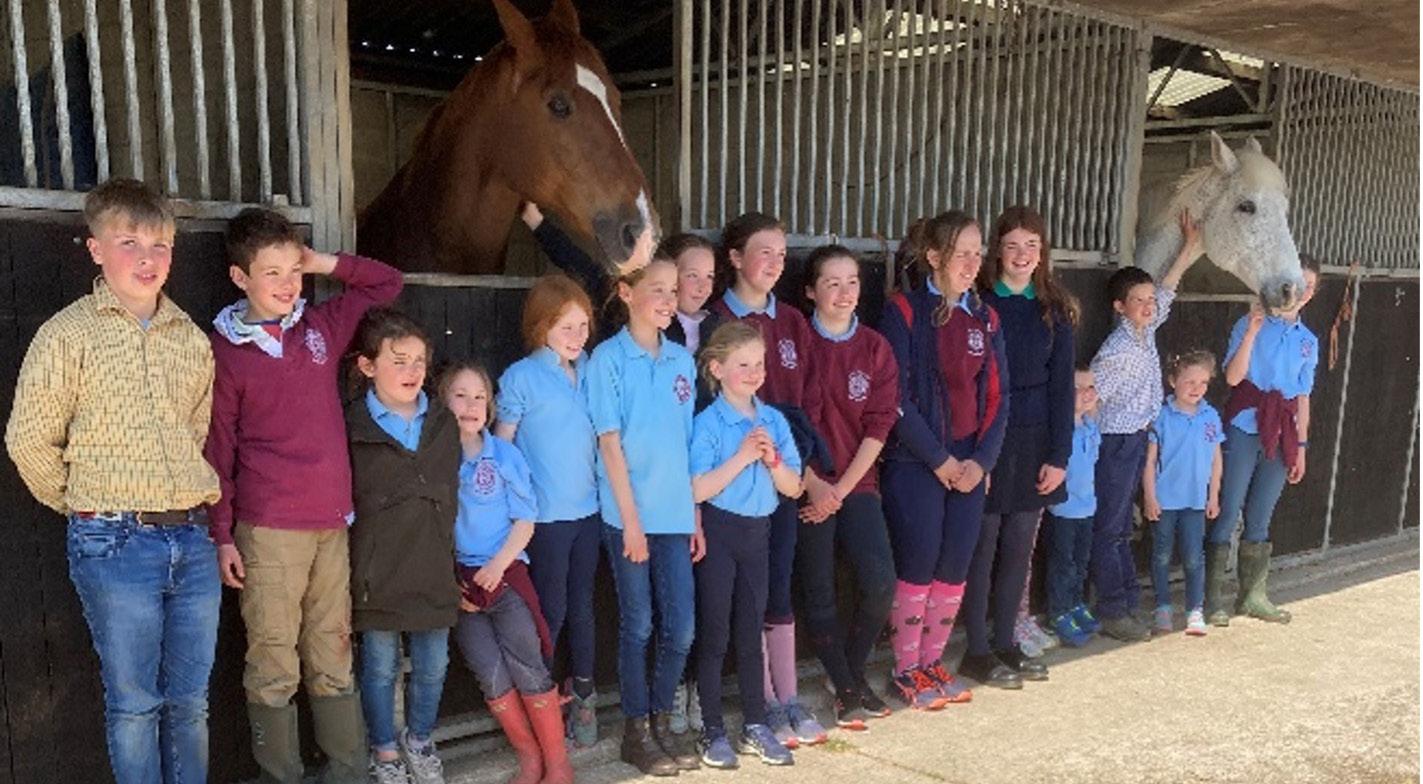
The annual summer show is another event which is always popular, and offers classes for all ages and disciplines.
The summer is great! But autumn has arrived – it’s back to school, and now the winter programme gets under way.
If you’d like to find out more about Pony Club activities, and to find your local club, then take a look at pcuk.org.
In September the Thoroughbred racing and breeding industry lost its foremost patron with the death of Her Majesty Queen Elizabeth II.
The Queen’s long association with the sport began with her first runner Astrakhan on 7th October 1949. Her first winner, Monaveen, was just three days later. Her final winner, Love Affairs, was at Goodwood on 6th September, just two days prior to her death. Her horses collectively won 1,121 races – 14 Group/Grade 1 wins, four Classics, and she was Champion Owner twice.
Possibly not so well known was her success as a breeder. Her Majesty’s first notable breeding success was in 1958, when her home bred colt Pall Mall won the 2,000 Guineas at Newmarket and went on to win two consecutive runnings of the Group 1 Lockinge Stakes at Newbury.
In the 1970s, the Queen bred two dual classic winners. Firstly, the filly Highclere, won the 1,000 Guineas at Newmarket and then went to Chantilly in France to win the Prix de Diane (French Oaks).

In 1977, the Queen’s Silver Jubilee year, the filly Dunfermline won The Oaks at Epsom and the St Leger at Doncaster – the latter race making Dunfermline the only horse to defeat the great Alleged.
Probably the crowning achievement of Her Majesty’s breeding operation was a daughter of Highclere, named Height of Fashion. As a two-yearold, the filly won several top races, including the now Group 1 Fillies Mile at Newmarket and The Princess of Wales Stakes as a three-year-old.
It was as a broodmare, however, that Height of Fashion really excelled. She was the dam of the 2,000 Guineas and Derby winning colt Nashwan, the Group 1 winning colt Nayef and the
talented multiple Group winning Unfuwain. The irony for Her Majesty was that she had sold Height of Fashion at the end of her racing career to Sheikh Hamdan Al Maktoum, a member of Dubai’s ruling family.
One of the best examples of The Queen’s utter delight in horse racing was when her filly, Estimate – a gift from another prominent owner/breeder, The Aga Khan – won the premier Group 1 race at Royal Ascot, The Gold Cup in 2013. The Queen’s joyous celebrations in the Royal Box were beamed live to television viewers around the world (see video above).

The Royal connection with racing continues, with His Majesty King Charles’ first runner, Educator, on 29th September, who finished second at Salisbury and his first winner being Just Fine at Leicester on 4th October.

I am writing with a heavy heart as I hang up my competition boots for 2022, having just completed the last event of my season. It is, however, a great time to look back on the year – to analyse and reflect on the good and the bad from the season. No standout results this year as I moved out from Under 21s and the age categories into the professional environment.
However, Freebie and I did lead two big 3* international competitions after dressage. Although we then jumped double clear, we picked up time penalties because of the hard ground. It was a calculated decision – hopefully the right one for the horse’s future, but it was disappointing nevertheless.
I have also been working hard on building my partnership with my incredibly exciting New Zealand boy Equador MW, especially in the cross-country phase. Some consistent and quiet crosscountry training has taken place since our last run at Blair Castle, which was rewarded at Osberton with a much more confident run in the CCI3*L.
Cor Y Taran finished another Novice double clear, this time on a 27 Dressage at West Wilts, qualifying him for the Young Horse Championships at Osberton, which was thrilling. Considering he was new to me in the spring and had done very, very little, it is a credit to his talent and his brain that he achieved such a prestigious qualification. He produced a competitive dressage test and a super, confident cross-country round over a very challenging and difficult track in the rain.
I was thrilled with him. Sadly he got slightly overwhelmed in the showjumping and had three down, which is unlike him. But there was an enormous atmosphere and, for a young horse, he has achieved so much in a few months. I am super excited about his future.
The incredible excitement of Yasmin Ingham winning the individual Gold Medal at the World Eventing Championships at such a young age (25) has been absolutely inspirational to the whole of British Eventing!
I was on World Class with Yasmin and trained with her and her beautiful horse. Her hugely deserved success has driven my passion to achieve at top level. My horses will now all have a
short, well-deserved holiday of two weeks off in the field, while I have to go to America for a family occasion. I strongly believe in allowing them to have some time off in the fields – a vital part of their season. It allows for any stiffness or muscular soreness to be released. It also allows them to regain a bit of weight after spending the whole year fit, and it gives them time to relax mentally. Finally, it is a reward for them for all the hard work they have given me throughout the year. While my event season has come to a close, I am very much looking forward to watching the two remaining CCI5* left on the TV – Maryland in the States and Pau over in France – as well as the young horse world championships in a few weeks!

The end of the season allows time for reflection and learning – and a couple of weeks off for the four-legged members of the team, says Toots Bartlett
Toots has been building a partnership with her New Zealand boy, Equador MW, this season.

I recently found out that almond croissants are one of our brilliant BV Editor’s faves (true fact - Ed) so I thought they might be a nice recipe to include as the nights draw in and readers might be looking for something a little special for their Sunday brunch (you may also enjoy Heather’s breakfast pasties) This recipe is a little time-consuming (it involves repetitive steps and a double prove) so it’s not a lastminute option. But it isn’t complicated, and freshly baked croissants are simply impossible to beat. To make these as traditional plain croissants, simply remove the nuts and marzipan; the recipe works just as well without them. You can also switch up the added ingredients – I have been known to add jam instead of marzipan to the centre! It’s messier (it tends to squidge out the sides) but wonderful if you are looking for a sweet bake.
If you are feeling adventurous, this recipe can be made vegan. Use Stork baking block instead of butter. It softens much faster than butter so keep an eye on it and perhaps leave it longer in the fridge between folds. It does give you gloriously crispy vegan croissants though! Heather.
• 120g cold butter
• 40g melted butter
• 160ml of warm water
• 250g strong white flour
• 30g caster sugar
• 7g salt
• 1 sachet of fast-acting yeast (8.5g).
• marzipan
• flaked almonds
• a beaten egg to egg wash
• a little icing sugar
1. With a rolling pin (or something heavy), bash the cold butter into a flat rectangle about 1cm thick. Cover this in cling film and replace in the fridge.
2. In a jug, mix together the warm water, caster sugar, melted butter and yeast. Leave to sit for five minutes – the mixture will begin to froth.
3. In a large bowl (or the bowl of your stand mixer), add the flour and salt and mix. Then pour in the liquid mixture and mix together, either with a wooden spoon or the dough hook of the stand mixer. Once the mixture has come together, knead for 5-8 minutes (either with the dough hook and your stand mixer or by hand). If the mixture is very wet, add a little more strong flour and if too dry, then a little more water.
4. Leave the dough to prove in a lightly oiled bowl in a warm place, covered with a clean tea towel or oiled cling film, for one hour until it has doubled in size.
5. Once the dough has risen, place it onto a lightly floured surface and roll it out until 1cm thick. Place the cold, flat butter square into the centre of the dough and fold the dough around it so that the
Heather Brown is on the committee of the Guild of Food Writers; she is a home economist with a passion for Dorset’s brilliant foodie scene, as well as a dab hand at fixing websites, and with a penchant for taking a good foodie photo. Heather runs Dorset Foodie Feed, championing Dorset’s food and drink businesses, as well as working one-to-one with clients.

AND DRINK butter layer has been fully encased.
6. Roll out the dough with the butter inside until it is again about 1cm thick. Now fold the lower third of dough up to cover the central third, and then fold the top third over the top (like a letter going into an envelope). Cover with a tea towel and leave to rest for five minutes.
7. Rotate the dough 90º and repeat (roll out and fold into thirds).
8. Leave to rest again, then repeat one more time.
9. Cover the dough with cling film and return it to the fridge for 30 minutes for the butter to get hard again.
10. Now repeat the above folding, rotating, resting process (steps 6-9).
11. Back in fridge with the dough for 30 more minutes, and then repeat steps 6-9 for a third time.
12. Once you have reached this stage, you can leave the dough in the fridge overnight. If you are not going to do this, it needs at least an hour in the fridge.
13. Once the dough and butter is thoroughly cold again, remove from the fridge and roll it out until it is 0.5cm thick.
14. To make a croissant, you need to cut tall triangle shapes out of the dough. The easiest way I have found to do this is to cut the rolledout dough into strips about 10-15cm high. Then cut these rectangles into triangles by cutting diagonal lines corner-to-corner. This means there is very little wasted dough.
15. Now you have triangles, do the following with each one:
16. Take the base of the triangle (the shortest side) and place a small ball of marzipan so that it covers the bottom third of the triangle.
17. Starting at the base, roll up the triangle, encasing the marzipan inside. This should give you the familiar croissant shape with the small point of the triangle at the centre on top.
18. Place the croissants on a lined baking sheet. Cover loosely with a clean tea towel or cling film and leave in a warm place to rise for 90 minutes.
19. Pre-heat the oven to gas 6/180º fan.
20. Beat the egg and lightly brush over the tops of the croissants. Don’t be too liberal with the egg as it can seal the dough a little and stop some of the rise in the oven. Sprinkle with flaked almonds.

21. Bake in the oven for 10-15 minutes or until golden brown and risen.
22. Finish with a glamorous sprinkle of icing sugar if you wish.
A trip to Italy has wine merchant Sadie Wilkins thinking about avoiding the tourist traps and searching out the genuine local offerings
Last week I was staying on the beautiful Lake Garda in northern Italy, home to some incredibly popular and easy-drinking wines. The region’s cool climate produces some delicious vino –from the aromatic yet mineral delights of Alto Adige at the head of the lake to the juicy, ready-todrink young wines of Bardolino, not forgetting the fizzy and fruity Prosecco of Veneto, and the seductive appeal of a Valpolicella Ripasso. There’s something for everyone in Italy, and the North did not disappoint.
Whenever I am away, I try to support local growers by choosing their wines in restaurants, usually having asked the staff (some being sommeliers) on style and pairing etc. Why not live and breathe the terroir by drinking the local wine?

Context is everything – but it is a two-edged sword. On the one hand, it’s romantic to think we can bottle up a region and experience it anywhere in the world. But it is hard to replicate a magical holiday moment, when you don’t have the climate, the food or the lakeside view …
In Garda, you are surrounded by amazing whites, reds and rosés from winemaking families with true heritage. For a handful of Euros, in a local supermarket, you can buy a typical wine of the region. Because the area is so popular for tourists (we can understand why, it was our second visit and won’t be

our last), there are many wines available that reflect ‘the hits’ of the region. Drinking a Bardolino at a touristy lakeside restaurant is like buying a souvenir Big Ben keyring in Leicester Square – it’s symbolic of the area, but not unique or special.

We stumbled on a wine festival organised by Visit Bardolino –a four-day event showcasing amazing Bardolino producers. We met the fantastic Fererica Zeni, who was passionate about her Bardolino but insisted we should go and see her winery and try out the other wines she produces. She is a fifth generation winemaker wanting to continue with the quality and reputation her ancestors have carved out. The point I’m making is that you need to hunt down the stuff the locals drink. Find the local producers, head off the beaten track and resist the appeal of the easy-to-grab-while-pickingup-a-packet-of-Lays-and-abottle-of-water wines from a
supermarket.
Ask them that know Sampling Soave, Lugana, Valpolicella … Bardolino … made me really appreciate the choice we have in the UK. It also made me think about value for money. Many of the holidaymakers we talked to didn’t know that you can find these small-grower wines in the UK. Cantina del Garda Bardolino Chiarretto has in fact been one of our biggest selling rosés this summer at Vineyards and we always promote well-made wines with character.
It is hard to know, when you are first getting into wine, whether you are drinking an average wine of a region or a special one. That’s why making friends with your local wine merchant is always a good idea. Speak to folk who are passionate about wine and who drink a lot of it. That’s the secret of the trade and it works at all levels. Hunt down those in the know –it’s what we do on our travels!
Speak to folk who are passionate about wine and who drink a lot of itVineyards in Bardolino near Lake Garda
Carolyn Hopkins’ bright blue 1969 Citroen HY van (Susie) brightens up Shaftesbury High Street like a beacon attracting customers – but what it contains is more important. This tiny vintage truck is packed with a selection of delicious cheeses as it travels to markets around the Blackmore Vale. When I met Carolyn, she had just finished judging at the

‘It’s part of the annual Frome Cheese Show. I’m one of the judges and we get all kinds of artisan cheeses there. It started off the back of Cheddar and just grew. It’s very well known within the cheese industry.’
‘I used to manage Turnbulls in Shaftesbury (remember that
amazing shop?). I was taken on one Christmas and I stayed. When it closed in 2018, I knew I still wanted to do something with cheese. This job means I’m selling cheese all day. I have my van (the Truckle Truck) as I can’t face putting up a gazebo at markets! The van also attracts people, too.’
‘My best seller is Gorgonzola. It’s young, soft, gooey ... and I’ve sold out of it today.
‘There are also Cheddars from Westcombe Dairy and Montgomery. The tourists always look for Cheddar as they like to taste local cheeses. I’ve also got some artisan cheese here from Feltham’s Farm; I have Rebel Nun, but I think their new Gert Lush will turn out to be their bestseller.
‘We have some interesting

Somerset cheeses – not just Cheddar. Pennard Ridge produces cheese mainly from sheep, goats and buffalo. And White Lake makes cheeses mainly from sheep and goats. ‘And then we have Dorset Blue Vinny, of course. Their’s is a fantastic story with how they found an old recipe in the garage and started producing what was a forgotten recipe, almost lost forever. And now they have a large business.’

‘Some of it is always here. I also like the very weird and wonderful. And then there’s the reliable stuff that people can’t get enough of. And also the cheese story, so people come to look at what else is here.’ Apart from the story behind Dorset Blue Vinny, there’s a lovely Princess Alisia Victoria from Switzerland. It’s made by three brothers who live in the same valley and is named after the princess who worked with the Swiss Red Cross during World War Two.
‘Adapting to a small counter and shelf space. I have to be really strict with myself. If it doesn’t sell, I don’t carry it.’
What are you most proud of?
‘Just the way people have taken to this business, especially here in Shaftesbury. They have really taken it to heart. People are almost possessive, saying “Here’s our Truckle Truck!”.’
What’s next for Truckle Truck?
‘It’s tricky in the current climate. First, getting through Christmas. Then next year, I’m looking at cheese-related hot food like raclette. But there are quite a few logistics to sort out first.’
The Truckle Truck is at Shaftesbury Market on Thursday mornings and Wincanton on Fridays. Carolyn also visits Sherborne Farmers Market, Bowerchalke and Berwick St John. And if you want Gorgonzola, be early as it sells out fast! thetruckletruck.com


Buying from Carolyn means your own cheese choices can be informed and entertaining: Lincolnshire Poacher sits somewhere between a Cheddar and an Alpine cheese, with the buttery, savoury notes of the former blending into the sweet, nuttiness of the latter. Aged for up to 22 months, the Vintage develops a mellow bite to the finish.
Shropshire Blue is one of the mysteries of the cheese world. Originating in Scotland and now produced by Stilton makers, there are many theories behind the name. However it came to be, it’s a delightful cheese, smoother than Stilton and with a little sweetness to balance the blue. Last, but most definitely not least, is L’Etivaz Alpage.
We’ve had a few Alpage cheeses on the counter over the summer, and they’ve all been superb. This one is seeing the season out in style – flavours of sweet pear are followed by nuttiness and a hint of the farmyard to finish.
As the 2022 judging begins, LLTL founder Barbara Cossins shares the story of a 2021 entrant who used the awards as a springboard for their honey business

The entry deadline was last month – but really the 2022 Love Local Trust Local (LLTL) Awards are just beginning. This year some of the best-known Dorset food producers sit alongside exciting new names, and we have some wonderful stories, too, as each producer has their own inspiring journey to share. There’s delicious chocolates, melt in your mouth brownies, crunchy macaroons, delicious cheeses, real milk, incredible honey, great steak... not to mention the homemade gin, beer and wine; it was all in the entry list.
Honey by Ian is a small honey brand run by the Warmer Family: ‘Having gained the runner up award in the Honey category of the LLTL Awards in 2021, we were determined to learn from the experience, take on board the comments from the judges and other participants, and come back stronger in 2022. We became interested in bees several years ago when a huge swarm landed in our garden and settled in a hive we had put out just for decoration. ‘We realised how lucky we were – Ian quickly found a mentor to teach us, and we started gifting our honey to family and friends. During the first lockdown, our eldest daughter Maddy was home from university and needed a project. She persuaded us it would be a good idea to set up our own website and start having more of a presence on social media. She took her camera and a basket of our recently harvested local Ringwood honey, together with some of our beeswax candles,
and off she went to take photos in the nearby fields. Within a few weeks, we were up and running. While many businesses were closed and people were all working from home, we were happy to deliver honey to the local bakery, butcher and any essential shops that were allowed to stay open. We also enjoyed delivering to people in the local area (who were eating our honey almost as fast as we could supply it!). Our lovely customers would leave out their empty jars and we would collect them, leaving a full jar on the doorstep. We began to feel like we were an equivalent to the milkman, but with honey!
Spread the word ‘The LLTL Awards gave us the confidence we needed and made us realise we were doing something right. We are proud to be allowed to carry the Love Local Trust Local logo on our honey. We completely agree with the ethos and we are so proud to be a part of this venture. We realise that a big part of this is spreading the word and

promoting the fact that local produce is the healthiest, the tastiest and the best for our environment.
‘All of our delicious honey is raw, untreated and unpasteurised which helps preserve all the natural vitamins and enzymes. If you would like to try some please head to our website honeybyian.com’
With the global food challenges we’re facing at the moment, it’s even more important to help tell the stories and promote local, independent businesses that put their soul into their produce.
It is a neverending job to keep up with social media (and extremely time-consuming) so I can see why people shy away from it. But it’s such a necessary task for all businesses in today’s world, in order to share their stories.
LLTL entrants can rest assured, we will be telling their stories for them. We don’t want all the amazing Dorset producers to be the best kept secret around. Let’s tell the world!

Sweet chestnut trees kindly leave the nuts at their base, ready for collecting

Field Mushrooms can be found from summer to autumn, but I have found the peak season in these parts to be September and October. During this period, I can often spot them in a field as I am driving around, at which point I tend to hit the brakes and work out where I can park (after checking my mirrors, obviously)!
One of the best things is that when you find some, you often find a lot.
Let’s start with one such bag filler - Field Mushrooms (Agaricus Campestris).
One of the best things about this mushroom is that when you find some, you often find a lot, meaning just one harvesting session can sometimes end up with me bringing home a year’s supply! Couple this with the fact that these mushrooms are really easy to preserve through dehydrating and I think you are
onto a winner.
As the summer crops hang on a little longer and the autumn season begins, October is the best month for foraging, says expert Carl Mintern October is here, and it’s perhaps the most exciting time to be a forager. Most of the tender plants are still hanging on in places, offering a rich assortment of wild salads and herbs, and the nut harvest is now in full swing. To top it all there is never a greater variety or abundance of wild edible mushrooms to choose from, meaning I can sometimes return from a trip to a woodland or footpath with bags of produce collected from high and low.
The Field Mushroom is found in grassland that is not intensively used by agriculture, meaning not monocultures where the use of pesticides is prevalent, but look for them on grazing pasture for sheep and the like. It is a saprobic mushroom, meaning it survives by recycling dead and decaying organic matter under the foliage of the grass. It can be found individually or in clumps, but also in partial or full rings, sometimes many metres across.
Look for a smooth and white cap which can develop a slightly darker centre with time. The young mushroom is domed, resembling the shape of a
closed cup mushroom from the supermarket, but the cap opens out to flat as it grows. The gills start off a delicate pink and turn brown then eventually black with age. The size of the cap is usually 3cm to 10cm and if handled roughly can bruise a very slight yellowish colour. The poisonous lookalike mushroom, helpfully called the Yellow Stainer, also stains yellow – but much more vividly. Luckily for us there is also another key identifier to help us differentiate between this delicious edible and its toxic cousin – smell.
The Yellow Stainer will smell of chemicals, rather than the usual ‘mushroomy’ smell we might expect, and this smell can be exaggerated by placing in the microwave for a few seconds if further reassurance is needed. As always, never munch on a hunch and be sure you have correctly identified your prize before eating!
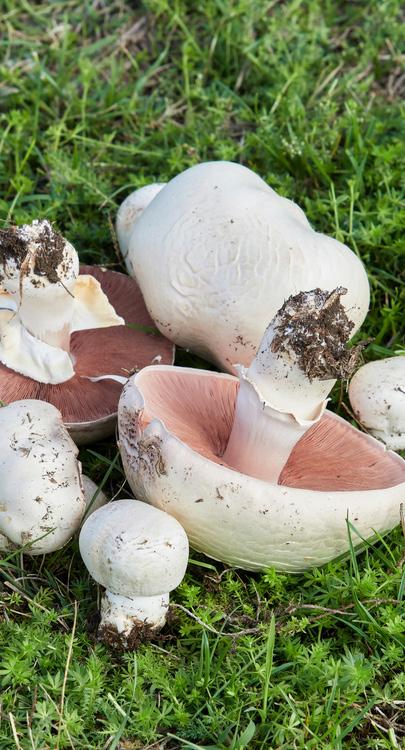
Next up on my free wild food shopping list is sweet chestnuts (Castanea sativa) – a delicious treat of sweet nuttiness, as the name suggests. Sweet chestnut is another wild edible that was introduced to Britain by the Romans, so we can add this nut to the list when answering that old chestnut, “what have the Romans ever done for us?”
Chestnuts can be cooked in any way imaginable; baked, roasted, boiled, or microwaved. But do ensure you score a cross in the shiny skin otherwise there is a high probability of exploding
when they are cooked!
After cooking, the options continue to expand. Eat them as-is, add them to desserts or make some stuffing. You can also puree them, store them in syrup or make delicious sweets from them.
Established trees will kindly leave the nuts at their base
ready for you to collect, and, with their unmistakable prickly shell, they are not easily confused with anything dangerous. Just be sure you know the difference between sweet chestnuts and conkers and you cannot go wrong ... unless of course you forget to bring gloves!

Autumn is the time to delay your daily walk until the light begins to fade, suggests wildlife writer Jane Adams – there’s a whole new world at dusk
Barn owl (Tyto alba) perched on a post at dusk.
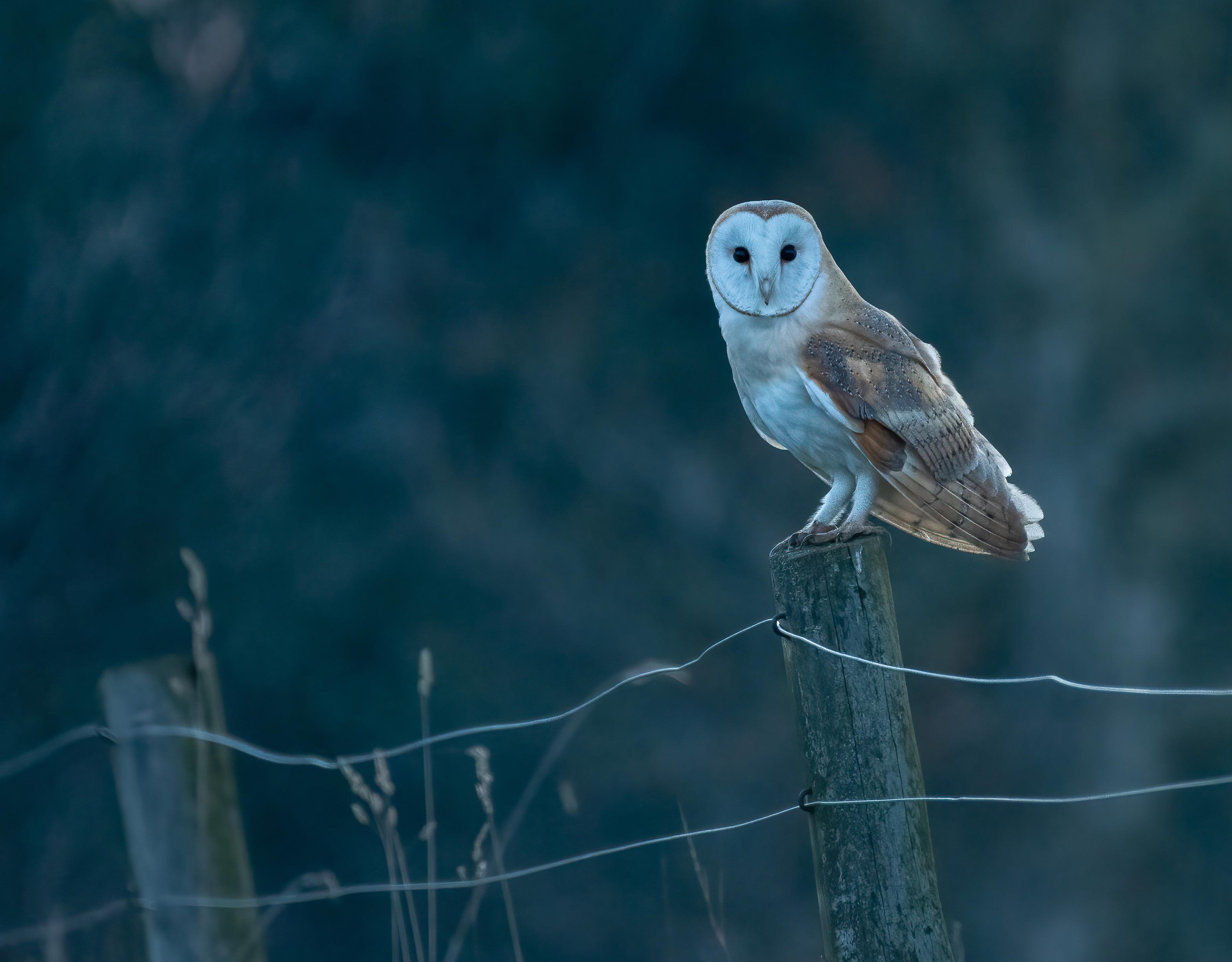
Autumn is a great time to experience wildlife, especially at dusk. A walk in the countryside when the light is fading can add a whole new dimension to the way we perceive the world. But don’t be surprised if it feels a little scary, that’s only to be expected. We humans are programmed to mistrust the uncertainty of darkness; no doubt a throwback to when our ancestors faced genuine risks from wild wolves and enemy tribes.
moonlit evening, when even a torch becomes unnecessary.
Many wild animals relax a little as darkness falls. With less traffic and people, they become more confident when cloaked in the safety of darkness.
territories. The hooohuhuhuhoooing of the male and the female’s ker-wicking contact calls often haunt the cooling air.
You might also hear sounds you don’t initially recognise. There could be a badger shuffling through the undergrowth, noisily scratching in the woodland loam for worms and slurping slugs from leaves.
Nowadays, though, tripping and stumbling into a low-growing branch are likely to be your biggest hazards!
So accept the tingle of uncertainty that trickles down your spine and pick a clear,
Or in the distance, you might hear deer stags bellowing and groaning as they vie for the right to breed, rivals jousting like medieval knights.
In October, tawny owls will be patrolling their wooded
Foxes will emerge, long-legged and agile, negotiating the ditches and fences, barely making a sound as they trot out to hunt over fallen leaves.
Take some time to listen, and breathe a little deeper. Find a tree trunk to rest against. Touch the leaves and soil beneath you, feel the texture of the velvet moss and iron-hard bark behind your head.
As summer dies, it feeds the earth, releasing the scent of autumn on the breeze.
Reconnect with the natural world. Then, when the time is right, wander (carefully) home.
Set in the beautiful Hooke valley, Kingcombe Meadows is one of the finest examples of lowland meadows in the country, a rare mosaic of habitats which is open for visitors to explore. Dorset Wildlife Trust purchased the Kingcombe land at auction in 1987 following a national appeal to save ‘the farm that time forgot’. From 1917, the land had been farmed by two generations of farmers in the traditional way, resulting in an unspoilt landscape. Retaining its patchwork of meadows, thick hedgerows and ancient green lanes, the land teems with an abundance of wildlife.
The woodlands, wildflower meadows, ponds and streams of Kingcombe Meadows are home to some of the rarest plants and animals in the UK. Yellowhammers and linnets make their home here and the ancient trees drip with lichens. The chalk slopes burst with spring cowslips, harebells and bee orchids while many species of waxcap fungi can be found in the acid grasslands. In summer, clouds of marbled white, meadow brown and ringlet butterflies can be seen.
We have lost, at a conservative estimate, more than before 97 per cent of the UK’s species-rich grassland in less than a century. An estimated 3,000 miles of hedgerows were destroyed each year between 1946 and 1963. Species like the grey long-eared bat, water vole and marsh fritillary butterfly are already on the verge of disappearing forever. Common wildlife like blue-tits, bumblebees and grasshoppers, plants and trees like bluebells

and oaks could be next. Making more space for nature is the key to reversing these declines.
Wildlife needs the chance to breed, feed and move freely beyond the boundaries of nature reserves. Part of Dorset Wildlife Trust’s strategy to create a Wilder Dorset by 2030 is to establish Nature Recovery Networks on land and sea. Together with local landowners, farmers and communities, the trust is working across 5,000 hectares to establish an ambitious nature recovery programme to enable Kingcombe’s wild energy to spread out through wildlife-rich corridors across Dorset. By replanting hedgerows, managing ponds and allowing billions of seeds from wildflower meadows to spread and grow, mammals, insects, amphibians and plants can thrive again and the landscape can recover … a winwin for nature and for humanity. As the President of The Wildlife Trusts, Sir David Attenborough said, “Everything works better when it’s connected.”
To find out about Dorset Wildlife Trust’s trailblazing Kingcombe’s Wild Energy project and how you can help reconnect nature, visit dorsetwildlifetrust.org.uk/WildEnergy
You may enjoy our Dorset walk which begins at the DWT Kingcombe Centre. It’s easy to just enjoy the first section through the Meadows themselves. The whole route is 13 miles, and one of our favourite, most beautiful walks – and don’t take our word for it, it gets 5* reviews too.
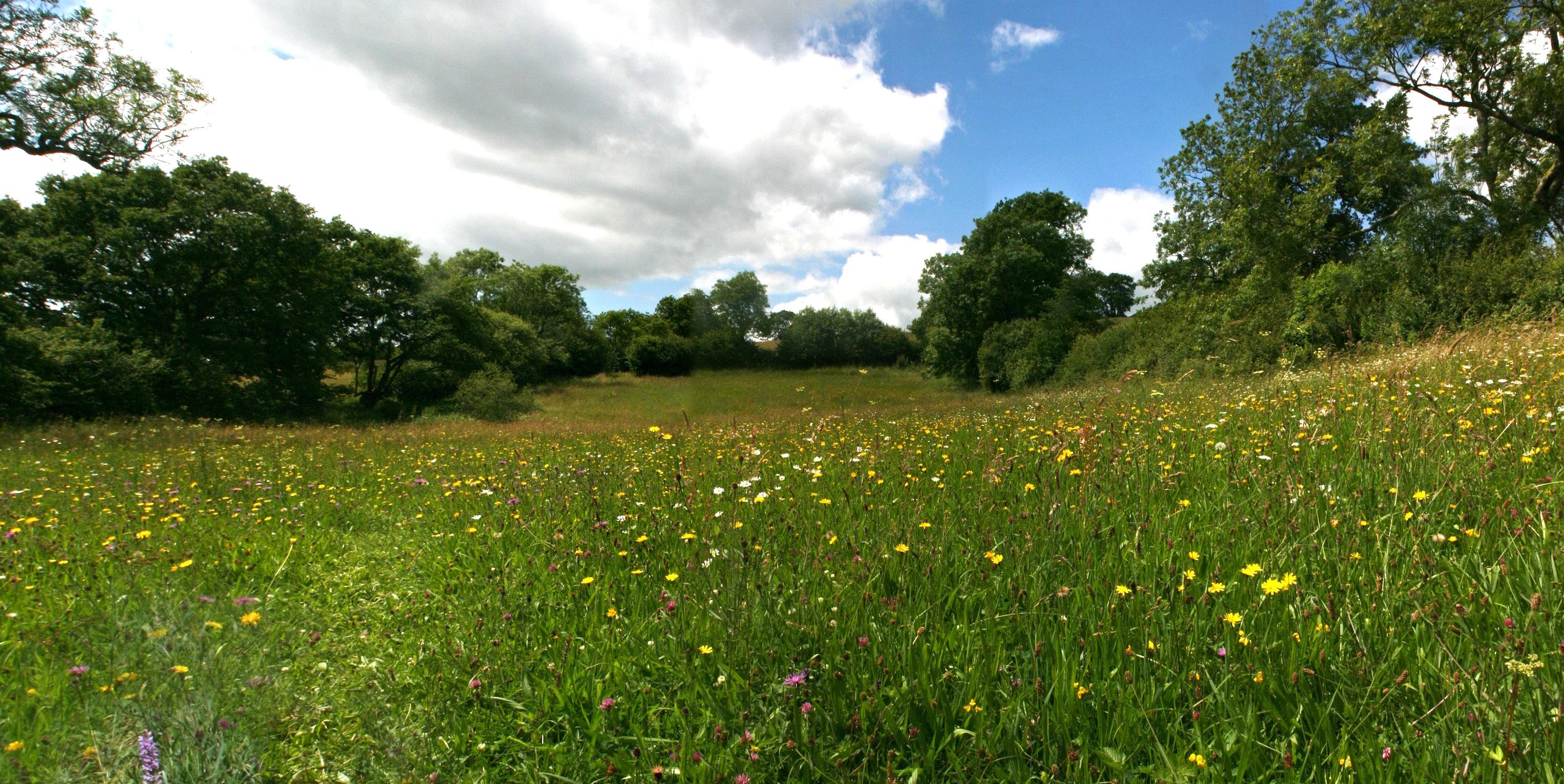
An estimated 3,000 miles of hedgerows lost each year between 1946 and 1964
Sunrise across farmland fields near Stalbridge
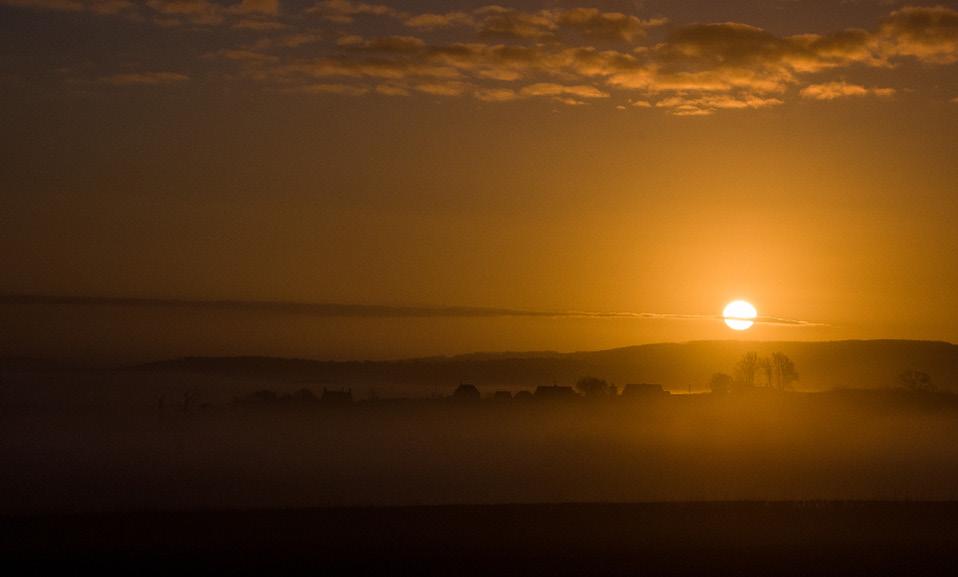
As has been described in this column over the past year, UK farming is experiencing some significant challenges; the prolonged dry weather over the summer, the changing policy environment and the everincreasing costs of inputs from seed and fertiliser through to labour and machinery, and, last but not least, energy. We are all well aware of the rising energy costs and this is being felt significantly on-farm. The NFU has been hearing some shocking figures in terms of price increases from members. The challenge of food security is ever increasing, particularly against the backdrop of the Ukraine invasion and its ramifications across the globe.
It is vital that UK farmers are able to continue to produce high welfare, high standard food for the nation, while at the same time protecting and enhancing the wonderful British countryside that we all love and
enjoy. This is key and the NFU absolutely believes that food production and the environment go hand in hand – and our domestic agricultural policy must allow this to take place.
The Environmental Land Management Scheme (ELMS) is the Government’s replacement offering for farmers following the removal of direct subsidy in the form of the Basic Payment Scheme.
The NFU has always maintained that it is vital that any scheme is fit for purpose, delivering for both food production and the environment, allowing our fantastic British farmers to farm profitably and productively as well as protecting and enhancing the natural environment.

Over recent weeks, reflecting the

changes in the Government and with the appointment of a new DEFRA Secretary of State in Ranil Jayawardena, there has been conversation about the progress of the roll out of the new ELM scheme. The NFU has once again repeated the message of the need for a scheme that is fit for purpose, delivering for both the environment and food production.
The NFU continues to represent its members at all levels. With party conference season in full swing, we have already had a key presence at the Labour and Conservative party conferences. Our President, Minette Batters, is meeting key ministers to ensure that the farming voice is hears, reinforcing the messages regarding for the ELMS to be fit for purposes to allow farm businesses a level of certainty and confidence.
As the challenges keep on coming, the NFU continues to represent UK farmers to policy makers, says county advisor Gemma Harvey
The challenge of food security is ever increasing

Despite the government’s plans to cap the cost of electricity for homes and businesses, the start of October once again saw the cost of lighting and heating increase.
The government’s intervention will have saved many farms around the country that typically survive on small profits. Nevertheless, the still-high costs remain crippling for so many small businesses.
I have heard of one large broiler farm spending tens of thousands of pounds on electricity for a crop, deciding to run their farm on a (much cheaper) red diesel generator.
Other farmers and landowners are being driven into green renewable energy solutions as they look to take their businesses off the national grid.
Farmers won’t just be cutting the power cables onto their farms figuratively; long term, investing in greener energy will actually save thousands of pounds.
Burn it or blow it The most popular green option is biomass, where organic material is burned in a boiler to produce high-pressure steam. This in turn rotates turbine blades to power a generator and produce
electricity.
The process releases some carbon dioxide, but nowhere near the amount released by conventional fossil fuels. Biomass is unsurprisingly popular on farms – they have surplus amounts of organic matter that are a by-product of their land and animals.
Even manure can be used, but it has to go through a lengthy period of moisture removal before it can be burned.
Another popular option, especially in hilly Dorset, is wind turbines – a truly green source, with the only side-effect being the noise of the turning turbines. On our farm at the top of Beaminster Downs, wind is our constant companion; we are currently considering installing one ourselves, although the local townsfolk may have some frustrations at what they would probably call an eyesore.
Of course, on the five days a year it’s not blowing a hurricane we are treated to some sunshine.
The shed roofs such as our hen house, are the perfect location for solar panels.
In the southwest, solar panels are the main source of renewable energy, with Butleigh Solar Park being one of the


main contributors. Companies installing freestanding solar panels insist that sheep can easily graze underneath them and that enough sunlight reaches the grass to grow for them to eat. Near the village where I grew up, there were plans for a large solar farm on the site of the old World Service radio transmitters.
However, the plans were quashed in Rampisham – when work on the infrastructure had already started – because an ecological survey discovered extremely rare grass …
Looking at the long-term picture, a year or so of astronomical electricity prices might turn out to be the very best thing for our carbon footprint.
If it takes the risk of bankruptcy to get farmers to turn green, then I say, so be it.
Rumours are circulating that the government is planning to renege on its targets to reach net zero by 2050.
Shame on Liz Truss and her government if they pull out. The NFU needs to stand strong and set an example by committing to net zero and committing to protecting the future of our country.
The current cost of energy may well prove the turning point in the country’s proactive adoption of renewables, says Andrew Livingston
Fifth generation farmer James Cossins ponders the annual when-to-sow gamble, a new herbal ley experiment and the dying art of ploughing.
As we move into October our thoughts turn to the autumn work programme on the farm.
The new grassland seeds have been sown, replacing some of the temporary grass fields which have had a particularly tough summer of heat and drought. We hope by planting new seeds, the fields will be much more productive than they were with the old grass.
We have also undertaken a trial in one field where part has been sown with ryegrasses and part with a herbal ley containing at least ten different species.
We are told that the herbal ley will be as productive as a more conventional grass ley over the period of the growing season, without the need for additional expensive fertiliser. It is also supposed to be more productive in drought conditions.
Our aim is to cut the field for silage and then use it for cattle grazing. I know organic farmers have been growing herbal leys for many years but it will be interesting to compare the two on our own farming system.
We will start sowing our winter

cereal crops of wheat and barley this month – while trying to get the timing right. Sowing too early can lead to crops becoming too lush and then susceptible to fungal diseases and insect attacks. But sow too late and the weather turns against us, the ground becoming too wet with potentially poor yields next summer. We aim to get them in by the end of October.
The milking cows have been enjoying their winter feed. Many of them have calved in the last two months. They are a lot happier going out to grass now there is actually something green to eat! Their calves are doing well in our new calf unit, where they are fed by a milk machine allowing them to have up to six feeds a day. Once settled into the system, they seem very content.
I attended the recent Blandford Young Farmers Ploughing match. It was great to see so many older tractors, with their two and three-furrow ploughs, competing. They were all ploughing with great skill – but

it is a skill that may soon be lost. We are all trying to reduce the cost of establishing crops and if we can reduce the amount of soil we move, it should save on the fuel we use. There are many different cultivators on the market, all trying to achieve the best seedbed. There are also seed drills that will sow straight into the soils without disturbing it at all. We are being told that this method is the best for the environment as the amount of carbon released into the atmosphere is minimised.
On the political front we now have a new Prime Minister and Environment Minister. Both, I believe, were involved with the recent trade deals with overseas countries. It has been muchpublicised that this government wants to reduce the amount of red tape that farmers have to deal with. I certainly support this in principle; complying with all the rules and regulations is definitely challenging. What I hope it doesn’t lead to is the lowering of food standards, so that imported foods – produced to lower standards than ours, using methods and inputs that are no longer permitted in this country – replace our UK produce.
I think it will be a case of watch this space to see what happens.
... Produced to lower standards than ours, using methods and inputs that are no longer permitted in this country
Ploughing at Rawston in the 1960s Image: James Cossins
As autumn gets into its stride it’s not all about the flowers, says KelsiDean Buck. Think about bring more of the outside inside this year

Our lawns are finally looking healthier thanks to the rain, and we’re in full swing of the new season.
At Thorngrove the seasonal bedding is on hand to bring some lush colour to your borders, planters, baskets, and pots. Pansies and violas are always the star of the bedding show at this time of year, and they never lose their charms. Dianthums, rudbeckia, and agastache are also all looking fabulous. We mentioned Cyclamen in the last issue, and they’re now ready to leave the glasshouses and take pride of place outdoors in your garden space.
Also on site we have new compost ranges arriving, with special offers for the new season too. Houseplants are becoming more popular again, as people spend more time indoors now the summer is over. Having a few plants inside your home brings many benefits, including purifying the air, offering a good screen distraction, and some studies showing they even help you sleep better! Check out our beautiful range when you next stop by.
We’re making some adjustments to signage on site and we are aiming to offer more insight, tips, and useful advice for everyone who visits. We understand that not everyone is an expert when it comes to choosing the right plants or in
how to care for them, so we want to make sure your visit to Thorngrove is as fruitful as can be. Keep your eyes peeled for this very soon!

Children can join our craftsmaster Claire during half term to make some unique seasonal creations (including custom Jam Jar Lanterns!) to take home with them. Safe for little hands, and perfect for the upcoming spookiest time of the year.
October 24th, 25th, 27th. 10am-12pm, £7 per child. Full details on the website here
The much-loved Winter Hanging Basket Workshops are back this
October, too. Join in for a demo, and then get creative with our gorgeous selection of winter basket plants, and take home something unique that you put together yourself under the expert guidance of Chris. We’d love to see you there! We’re also offering a great package with the hanging baskets and lunch.
Monday 17th to Saturday 22nd October daily. £10 for just the workshop demo (2pm-4pm) or £25 for the demo plus a two course lunch in the Secret Garden Café (12pm-2pm).
See our website for full details.
We look forward to seeing you this October!
A splash of autumnal colour from Thorngrove’s rudbeckia
After the hot dry summer, three inches of rain in September made a noticeable difference to the plot, never achieved by the watering, says Barry Cuff.


The much-needed rain arrived on 5th September, and by the 26th we had recorded about three inches. After a few days there was a marvellous revival of plant growth – rain can do wonders which are never achieved by watering alone. Growth was very noticeable on our carrots, leeks, parsnips and brassicas.
As well as the vegetables, there was an amazing emergence of weed seedlings on bare areas of the plot, the majority of them being chickweed. These will either be dug in with the green manure beans or hoed before they become too large.
The brassicas remain under netting because of the pigeon problem. Our brassicas are also suffering from the worst infestation of Whitefly in 30 years –looking at other allotment sites online this seems to be a common problem. Hopefully, a few autumn frosts will deal with the problem. Strangely there is very little caterpillar damage from the cabbage white butterflies – plenty of eggs have been laid, but they have not hatched.
Both our runner and French beans put out new flowers this month, which has given us a second crop of fresh beans. We continue to harvest carrots and beetroot when needed. We have enough carrots – Early Nantes – to last till at least February. They will suffer a little slug damage over the winter but will still be usable. So far we have cut four Cheesy cauliflowers of a reasonable size.
Three of our Crown Prince winter squashes were harvested on the 20th as the stalks were turning
yellow. The rest, together with the butternuts, will be ready in early October.
The celeriac have been mulched and fed to encourage large roots. These will be ready in December.
As our first sowing of oriental mustards was wiped out at the seedling stage by flea beetle during the drought, a second sowing was made on the 8th and is now looking well.
Both our autumn raspberries (Joan J and Autumn Treasure) are now cropping well. In the greenhouse the hot chilli peppers are turning colour and we have picked Hot Scotch and Habanero Orange.
Now we have to start planning for 2023. A phone call to the farmer has secured our delivery of wellrotted horse manure in November. Seed catalogues have been ordered, and Kings has already arrived. Belonging to the South West Counties Allotment Association, we are eligible for a 50 per cent discount on all seeds from both Kings and Suttons.

It’s going to be a busy autumn – gardener Pete Harcom shares his list of clean up jobs for the winter, as well as planting tips to be ready for spring
We can now look forward to the spectacular display of colours from our deciduous trees and shrubs.

In general terms, autumn is the best time for planting trees and shrubs and hedges. Here are a few jobs to be getting on with this month:
• Clean up the greenhouse and move any potted or planted frost-vulnerable plants (like fuchsias and pelargoniums) into the greenhouse to overwinter. If you have limited space, put the plants together in a long flower pot (window-box type).
• Make sure you have your sweet pea seeds ready for a winter sowing.
• Collect seeds from hardy perennials and sow them in a cold greenhouse now.
• If you have shade paint on your greenhouse glass, now is the time to remove it. While it is dry, remove the paint carefully with a dry cloth. This will let in more light and help grab as much of the sun’s heat as possible on cooler days.
• Clear up your borders; remove the annuals and plant up for spring with wallflowers, pansies, hellebores and perhaps Bellis perennis daisies.
• Be sure to plant some flowering bulbs to help the bees when they emerge from hibernation – crocus, snake’s head fritillary, winter-flowering clematis and grape hyacinths are all particularly good for bees. Bees that emerge too early from hibernation on sunny winter days are in danger
of dying if they don’t find a source of food quickly, so by providing a constant source of nectar in your garden, you can really help them on their way.
• Cut back, divide and replant your herbaceous perennials.
• Protect half-hardy plants with leaf mould or compost if you are leaving them in the garden borders. Hardy fuchsias will definitely benefit from this.
• Hedgehogs will really benefit from extra food now, especially as they will be needing to fatten up before their winter hibernation. No need to buy expensive products – local hedgehog
rescue centres feed them on dry complete kitten food.
• Keep rose beds and plants clear of fallen rose leaves, especially if black spot is a problem.
• Complete the pruning of rambling and climbing roses.
Here’s an interesting plant for you to try – Trillium erectum, or wakerobin. Fully hardy and perennial, these wildflowers from North America are plants of open woodland, so filtered shade is needed rather than full shade. They flower from April to May, and reach around 30cm. They need a humus-rich soil that is well-drained, but not tooled.

It’s good to have a tidy up, but don’t rush it, says flower farmer Charlotte Tombs. There’s lots of goodness in those last remains of the summer
What a strange concept it is, putting a garden ‘to bed’ –though I’ll admit it’s always nice to see everything cleared away and put on the compost heap, burnt or taken to the municipal dump. It’s just as well that there really is no hurry to get on with it. I’m in the middle of organising Christmas workshops... (shameless plug to follow).
If you take a moment now, you can organise your current garden mess to benefit your growing season for next year. Try cutting back all the dead woody stems and then use them as a mulch on your flower beds; the insects will be able to overwinter here, and it will provide food for the birds. Leave the root balls in place. They will add to your soil’s health and increase the good microorganisms.
Leave anything with a seed head. Not only will it look beautifully architectural on a cold frosty morning, the birds will thank you for these extra seedy treats. You will find with the fluctuating autumnal temperatures that some seeds will start to self-sow.
Use this as nature’s indicator that now is the correct time to plant your autumn hardy annuals such as cornflowers, Ammi majus (Queen Anne’s lace) and calendula by sowing these now. Your seedlings will have a jump on next year, and it’s always good to get ahead. Plus you will find that these autumnsown plants are bigger and healthier than their spring-sown counterparts.
Some seeds need something called cold stratification – a period of cold to germinate.
Orlaya and Larkspur benefit from this treatment, and in fact
Leave your dahlias till the frosts turn them black Image: Charlotte Tombs
I have a Ziplock bag of seeds in my fridge all year round!
Do wait for a couple of hard frosts to knock your dahlias back (wait until the frost hits them and they go all black) before you lift to store, or leave the tubers in and mulch – it all really depends on your soil type. If you have free draining

ground you are probably OK to leave in, but if the ground is subject to standing water they are likely to rot. Dahlias do like being dug up and divided every few years, it encourages more vigorous growth (plus you get free plants). I usually lift some and leave some, but then one of my absolute favourites rotted in storage but was fine in the ground, so it’s always a gamble!
This year I am running two workshops:
• 12th November - Christmas stencilling in the morning with Melanie Ward, and wreath-making in the afternoon with Charlotte
• 30th November - Indian cookery with Christmas wreath. Hands-on Indian cooking with Torie True in the morning, with a leisurely lunch of the dishes you prepared. An afternoon Christmas wreath workshop using lots of different elements grown and foraged by Northcombe Flowers.
Both of these make great gifts for that person who has everything – or simply to treat yourself. Please take a look at my instagram account @northcombeflowers for details and book classes early to avoid disappointment!
Charlotte offers workshops throughout the year - please see northcombe.co.uk for further details.
Simply click to complete on your tablet, computer or phone - or there’s a download option if you prefer pen and paper.


Jigsaw A busy bee on the brambles at the end of a gloriously warm September day. Just click to complete! If you get stuck, there’s an icon at the top of the screen which reveals the completed picture for you to refresh your memory. Image © Courtenay Hitchcock
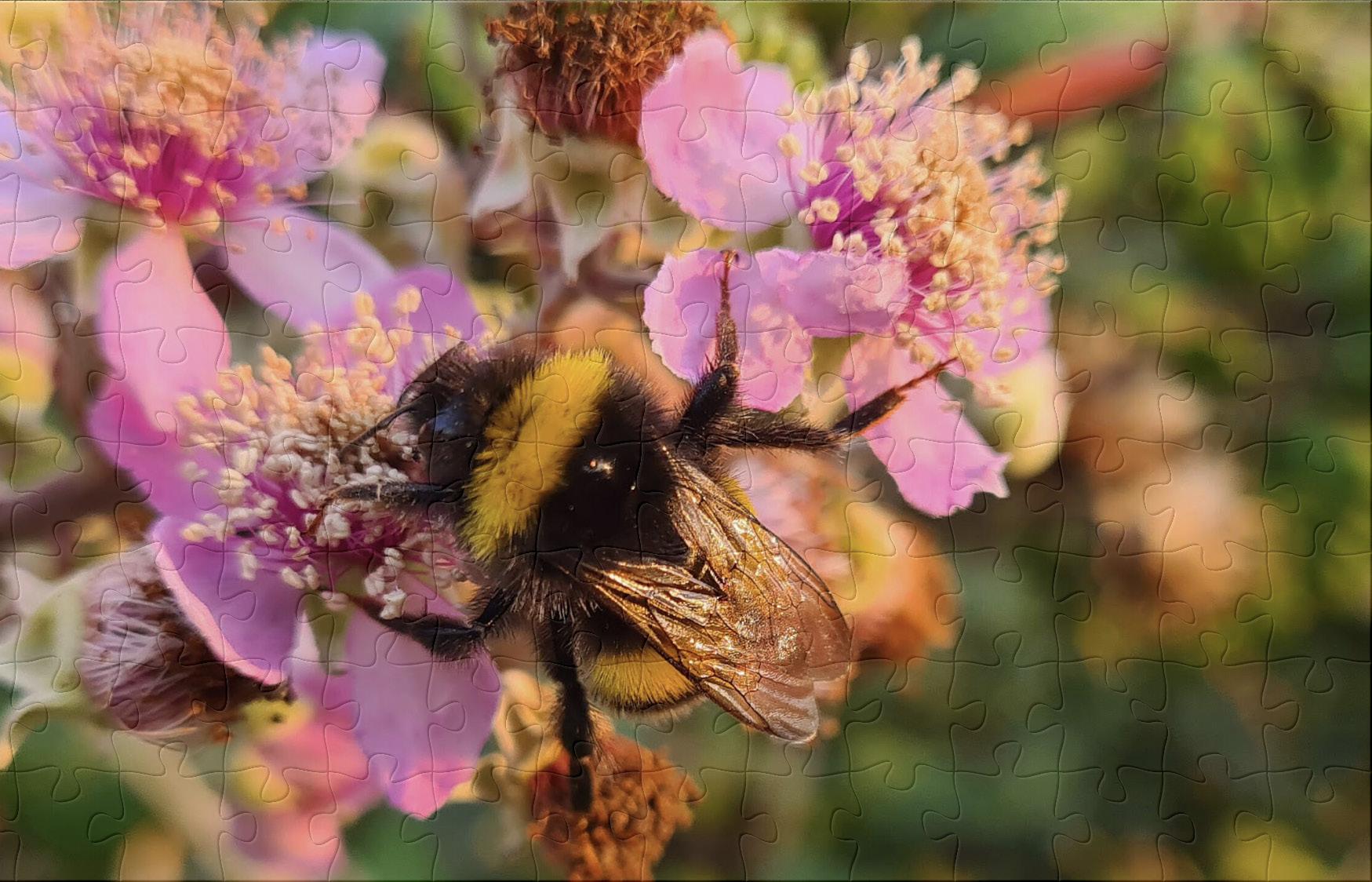
Want to reply? Read something you feel needs commenting on? Our postbag is open! Please send emails to letters@theblackmorevale.co.uk.
When writing, please include your full name and address; we will not print this, but do require it.
What a fantastic ‘Dorset Island Discs’ this month (‘ The NHS has lost its way ’, Sep 22)! The column is always an enjoyable read, and your varied guest range is particularly interesting – as a Dorset resident I’m rather ashamed to admit I hadn’t heard of Patricia Miller before. Not only was hers an inspiring story of a woman rising up against the odds, but what a thought-provoking and insightful interview into our health.
I’m not sure I had ever grasped before that a mere 20 per cent of our health is actually about our physical wellness; the rest being all about where we live, our education, our jobs...
Fascinating stuff - and I can only imagine the frustrations of this being your work, when set against so many obstacles. And how can we not appreciate a woman in such an important, powerful role who proudly picks Cameo alongside the Greatest Showman and Bob Marley?!
Anne Grey Nr. Verwood
Just a quick note to thank you for your feature on Patricia Miller - though disguised as a fluff piece (rude! - Ed) her interview was insightful, intelligent, thoughtful and thought-provoking.
And as a bonus it reminded me how much I used to enjoy Anita Baker! Charlotte B Blandford
I was interested in your article on the modern wool industry (‘We need more woolly thinking’, Sep 22).
There have been some amazing innovations in the wool industry – but there are so many more opportunities still to be taken advantage of. British wool is unique because, unlike many other breeds of sheep like merino, British fleeces tend to make coarser, scratchier wool.
This was once a competitive advantage, when our carpet industry was booming. But as carpet sales slumped and the fashion for hard-wood floors arrived, wool prices began to plunge.
From being a prime trading product, a decade ago wool had become a simple by-product and farmers began burning fleeces because it was no longer economically effective to lug them to market.
Of course we can wear it (though for a ‘waste’ product it seems to be remarkably expensive to buy pure wool clothing) or use it for building insulation, but some entrepreneurs have really started exploring its potential.
Solidwool is a sustainable alternative to fibreglass.
Woolly Shepherd make sound absorbers.
ChimneySheep make rolls of gardeners felt (perfect mulch, plants love growing in it and it biodegrades within a year)
Woolcool make felt liners for insulating boxes to transport
food - anyone who has one of those meal subscriptions from HelloFresh or Abel&Cole will know them. Far more importantly they’re also used for vaccine transport.
On top of all this, it’s also used for cleaning up oil spills, it is fully biodegradable and 100 per cent renewable.
WHY is it still seen as a waste product? I cannot understand it.
Having left school in 1946 I worked in London for a Belgian Wool Merchants with strong connections to the Wool Futures Market, representing company branches from around the world. London having suffered and survived the Blitz was an exciting place to work, especially for a young girl having just left school, with rationing and ration books the mainstay of our lives.
I was fortunate in that we received gift aid parcels from the firm’s American connections containing nylon stockings and nylon material (which made wonderfully luxurious underwear!), together with parcels from Australia containing skeins of wool.
I particularly recall some beautiful soft green merino wool. While sitting on the steam train travelling into London every day I knitted it into a long sleeveless cardigan – which after 74 years, still being as good as new, I am wearing today! Oh happy days!
***
A note from Canada
I write from Canada, where the Blackmore connection to the Queen is that my father in law
was Lieutenant Governor of Ontario. In other words he was Her Majesty’s representative for the province.
I met her twice, and she was such a wonderful lady. Hard to imagine a world without her. My grandfather Wallace Blackmore left school at a very young age and joined the White Star line (I believe his father or grandfather was a millwright in the Devonshire area). After a few years he jumped ship in New York in 1912 and hitchhiked to Windsor here in Ontario and eventually opened his own bakery under the Blackmore name.
If he had not jumped ship in New York his next assignment for White Star was to be on the maiden voyage of the Titanic… I was hoping to take my wife back To the UK last year but COVID got in the way. Hopefully we will be able to make the trip next year. All the best from Canada!
Tom Blackmore Ontario *** Variable billsIt seems very few people know about Variable Direct Debits. If you are good at budgeting, it is a much better way to pay for your utilities. You send in your monthly meter readings, and get the bill a few days later. A week after that, the exact amount you have used is taken from your bank.
Definitely no need for an astronomical monthly direct debit. My bill for August was less than £25. My whole year’s usage was less than £600. Use less and you pay less. (Excellent magazine - keep up the good work!)
C. Willment By emailTaken by Lily Pearson, aged six, from her bedroom window, looking over the M&S car park in Blandford. Sent to us by her mum, who says Lily is a very keen photographer.

A wonderful ecumenical Evensong took place on Thursday, 16th September at The Sacred Heart Church in Tisbury. Father Robert is not one who likes a fuss but thought this would be a rather good idea.
And he was right!
The Revd. Juliette Hulme kindly led the service. Father Robert sat by the font where he could see and then speak to all as they came by.
It was a splendid farewell, the church was filled with our parishioners, our Dean, Father Anthony, those from St John’s, the Methodist church and Tisbury community.
Mark Shuldham welcomed everyone; Teresa Frost and Mark read the lessons. The choir sang from the gallery in the west end and consisted of members of the Hindon & Chilmark Choir and those of Wardour and the Sacred Heart, led by Felicity Pattenden.
The BCP Evensong, which was at the request of Fr Robert,
opened with the choir singing a four-part round of a Taizé Gloria. The canticles of the Magnificat and Nunc Dimittis were sung to settings by Smart and Monk. The anthem, Schubert’s Ave Maria, was performed beautifully by Soprano Iuno Connolly. Organist Douglas Stevens accompanied us all as proficiently as ever.
Father Robert joined us all afterwards for refreshments in the Parish Room.
A collection was taken for Stella Maris, a charity for seafarers which is dear to Fr Robert’s heart. He has written several books about seafaring and One Firm
Anchor includes the history of this organisation, Apostleship of the Sea, now Stella Maris.
Thank you to all those who took part, to Revd Juliette Hulme and to Felicity and the Choir, Douglas our organist, readers, helpers and the Social Committee for refreshments.
Catherine Vaux TisburyThis month’s news from the unofficial capital of the Blackmore Vale ...

Calling all parents and carers - The Boutique at Sturminster Newton’s Market Cross accepts outgrown items of school uniform for William Barnes and for Sturminster Newton High School. It is also delighted to give free items to whoever wants them –children grow so fast, it makes sense to recycle if possible, rather than buy new.

A wide range of furniture, which is too big to display in The Emporium, is included in the catalogue. Customers can choose items from photographs and then arrange to see them in nearby storage. The Emporium’s Recycled Art Gallery on the upper floor is continuing to be popular and sometimes turns up some very interesting finds.
• Update on the 1855 project in the former NatWest Bank. Work continues and we aim to open in time for the town’s
The Boutique has switched its range for the colder weather – and is getting ready for party season

1855stur@gmail.com. In particular, they would like to hear from authors wishing to rent shelf space to sell their books –they would love to develop an area where customers can buy new books in the town. Next year, during phase two, more hanging space will be available for painters and photographers.
• Posh frocks for party season
Remember that The Boutique and Dapper Chaps are both good places to look for Christmas party outfits. Meanwhile the summer stock is giving way to warmer wear for winter.
Chris Spackman and Mike Chapman are offering help with financial and business planning, marketing etc. to those thinking of setting up their own businesses. They are holding a launch meeting from 6.30pm on Monday, 10th October, in the Baxter Room above The Emporium. To book a place or learn more contact Chris Spackman on chrisjspackman@
yahoo.co.uk or telephone 07771 517913.
The regular Stur meet continues at the Recreation Ground on the first Saturday of November, from 9am to noon (no need for 12)
All those with interesting vehicles or motorbikes are welcome, as are spectators.
From December to March, the organisers intend to move the event to the car park behind the Exchange Medical Centre. For information contact Chris Spackman chrisjspackman@ yahoo.co.uk or telephone 07771 517913.
Even Noddy turned up last time ...

Preparations are underway for the annual Christmas event in the town. The Christmas tree lights will be switched on at 6.30pm on Saturday 26th November – all art of “Make Stur Sparkle.”
A craft market is planned in The Exchange and the Anonymous Travelling Market will be in the Market Place. And of course
Father Christmas will be in

attendance. (then paragraph)
Organisers plan a synthetic ice skating rink in the town over the weekend. Late night shopping and live music are also on the agenda for the weekend – and yes, this coincides with the football World Cup so fit your shopping round it or come out and escape it!
Employ My Ability offers vocational training for students with learning disabilities and special educational needs and disabilities. One of their students, Maddie Walters, spent her last term working on her journalism skills with the aim of writing a column for us. - Ed
Hello everyone, how was your September? As summer ends, this month I’m going to review one of my favourite places to visit – Sculpture by the Lakes in Dorchester.
Sculpture by the Lakes is a beautiful garden that has amazing statues and great scenery. It is a fantastic place to visit, and it is a very disabledfriendly place to go. The gardens are incredibly beautiful, and amazing for people who have special needs. The sculptures are fantastic to
look at, and they can be a bit different.
In a small building there is a special art gallery that is full of amazing discoveries. When you go inside it has miniaturesized sculptures as well as some beautiful artwork displayed. It is a wonderful place to look around, especially when you learn about history through art.
It is suitable for almost anyonebut children under 14, including
babies, aren’t allowed. Nor are dogs. It is perfect for an end of summer trip for anyone who really likes fantastic scenery.
If you’re thinking of planning your visit booking is essential on the website, the cost is £14.50 per person. The winter opening hours (which started on the 1st of October) are 10am to 5pm Tuesday to Saturday.
I hope you enjoyed this review and have a wonderful day everyone.
Maddie Walters
Thanks to donations from the annual lodge of instruction dinner of The Lodge of Honour and Friendship, Blandford-based charity ‘New Opportunities for Community and Support ’ (NOCS) has purchased new furniture and refurbished it premises. NOCS Charity provides support, development opportunities and fun for people with high levels of
social anxiety and difficulties with social interaction, particularly due to autism spectrum disorder (ASD), such as Asperger’s, or mental health challenges. Blandford councillor and the charity’s founder of NOCS Nocturin Lacey-Clarke said, ‘This donation was a wonderful extra for our small charity. It means we are able to ensure that maximum
funding goes on our day-to-day activities.’
Andrew Ward, Master of The Lodge of Honour and Friendship said ‘This is what Freemasonry really is all about, the difference that we can make to small local charities, with focussed goals, is amazing. The work that they do at NOCS is great and we’re really happy to be able support’.
The Dorchester Market Car Boot Fund is now open for applications from community and voluntary organisations working in and around Dorchester.
The fund comes from weekly car boot sales held in Dorchester and will be distributed to local community and voluntary organisations to benefit projects operating within or supporting residents living in the area. In 2020, over £13,000 was awarded to local community and voluntary organisations in Dorchester.
Among the organisations who received funding in 2020 were Bradford Peverell Village Hall who received £1,000 towards the replacement of their roof and Homestart West Dorset who received £1,500 towards their running costs.
Cllr Molly Rennie, Chair of the Dorchester Market Car Boot Grant Panel said: ‘It was wonderful to award over £13,000 to local organisations. We recognise the hard work that they do to make lives better for others.’
The 2022/23 car boot fund is open until midnight Saturday 12th November 2022.
Decisions will be made at the end of November, and groups will be notified before the Christmas break.
Successful applicants will be invited to a celebration event next year to share news about their projects.
An application form and additional guidance can be found on the Dorset Council website
The Open Garden at Hatch House has this year raised in excess of £20,000 for Salisbury Hospice. The annual event, held on Saturday the 10th of September this year, is always hosted by Sir Henry and Lady Rumbold and organised by the Tisbury Fundraising Committee.
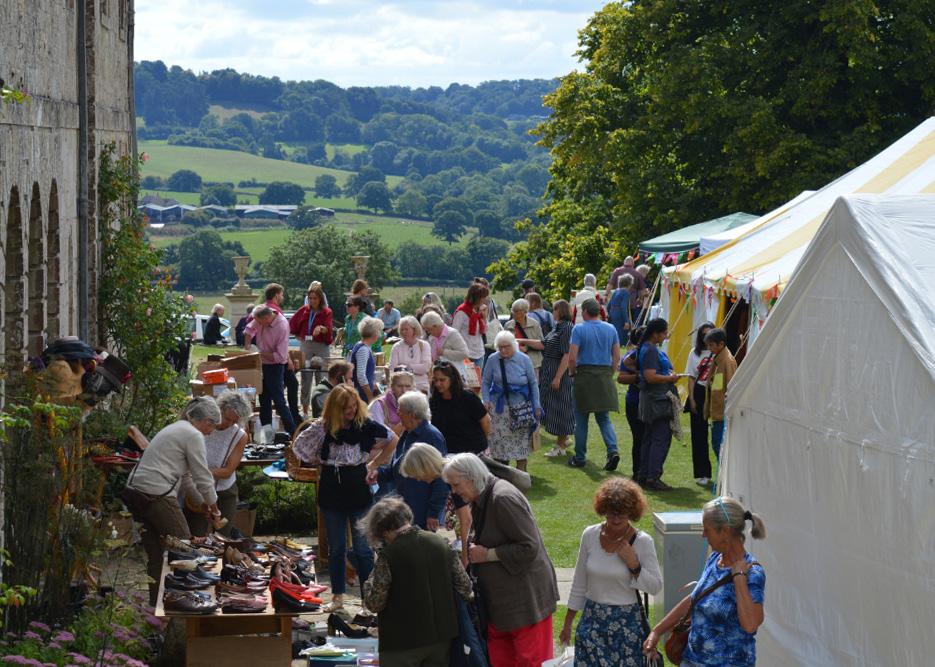
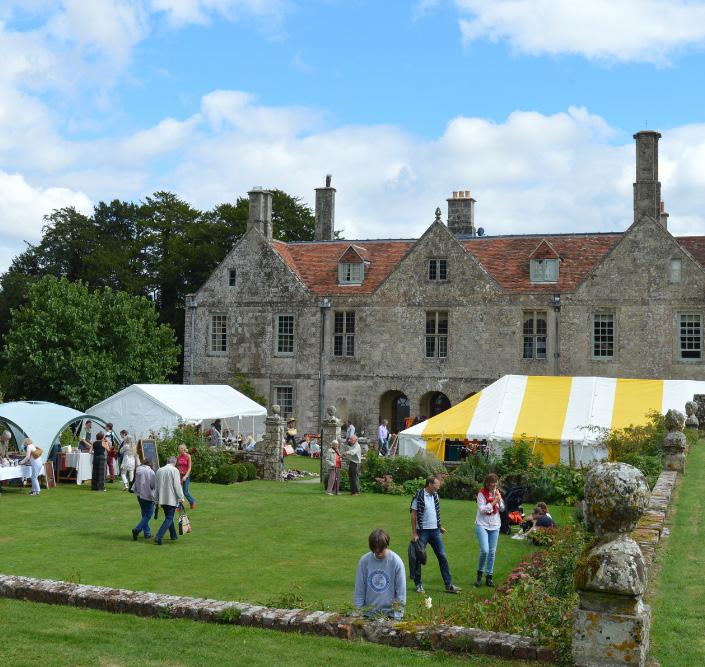
The event is beloved for its vintage and pre-loved designer clothes, shoes, hats and bags, but the varied stalls also include antiques and collectables, raffle, cakes, organic produce, local honey, plants, ethical gifts and homewares, jumble and books. Refreshments were provided by a team of wonderful volunteers and a barbecue by Compton McRae. The glorious weather ensured guests could make the most of the outdoors and were able to sit and enjoy the idyllic scenery that surrounds the house.
All leftover items from the stalls were donated to Alabaré, a local charity that supports the homeless. Salisbury Hospice Charity are keen to thank Sir Henry and Lady Rumbold for once again welcoming the

event to the grounds of Hatch House. Notable thanks went to Lady Rumbold and her team of helpers for their many hours of organising the clothes for sale, the entire Tisbury committee for their hard work organising and running the event and all the Hospice volunteers who helped the event run so smoothly. Salisbury Hospice say the money will fund vital hospice services, ensuring the service remains free to patients and their families.
Tamsin Murley, Community fundraiser for Salisbury Hospice Charity said: ‘I am delighted to announce the huge fundraising total for this event, and express our huge gratitude to the Tisbury Committee and all extended volunteers. The continued support shown by Sir Henry & Lady Rumbold is phenomenal and they are without doubt the heart and soul of this event. We look forward to seeing you all again next year!’
Pupils and teachers at St Mary’s Primary School in Bradford Abbas are delighted to have been awarded the Sports Mark Gold Award! This national award recognises and celebrates the opportunities and experiences the children receive in sports and health education.

Headteacher Emma Grunnill said: ‘Our staff work incredibly hard to ensure that our pupils have expert tuition and quality experiences in sport. I am delighted that the hard work, commitment and achievement of the staff and children has been recognised. A huge well done and thank you to them.’
Piddle Valley CE First School has been working hard on improvements to the outdoor environment. This includes renewing the raised beds in the gardening area and creating a new pond area. There is still lots of planting to do but the staff and children are all excited about encouraging the wildlife to the area.

The new raised beds have already been put to good use by the Gardening Club, an after school club who meet weekly. So far they have hosted three ‘Piddle Produce’ markets which have been extremely popular, selling school-grown produce including carrots, lettuce, beetroot, tomatoes, apples and herbs.
To date the children of the Gardening Club have raised £60, which they will use to buy further seeds and plants for the garden. The parents and families have been very supportive of the Piddle Produce markets which has been very much appreciated.
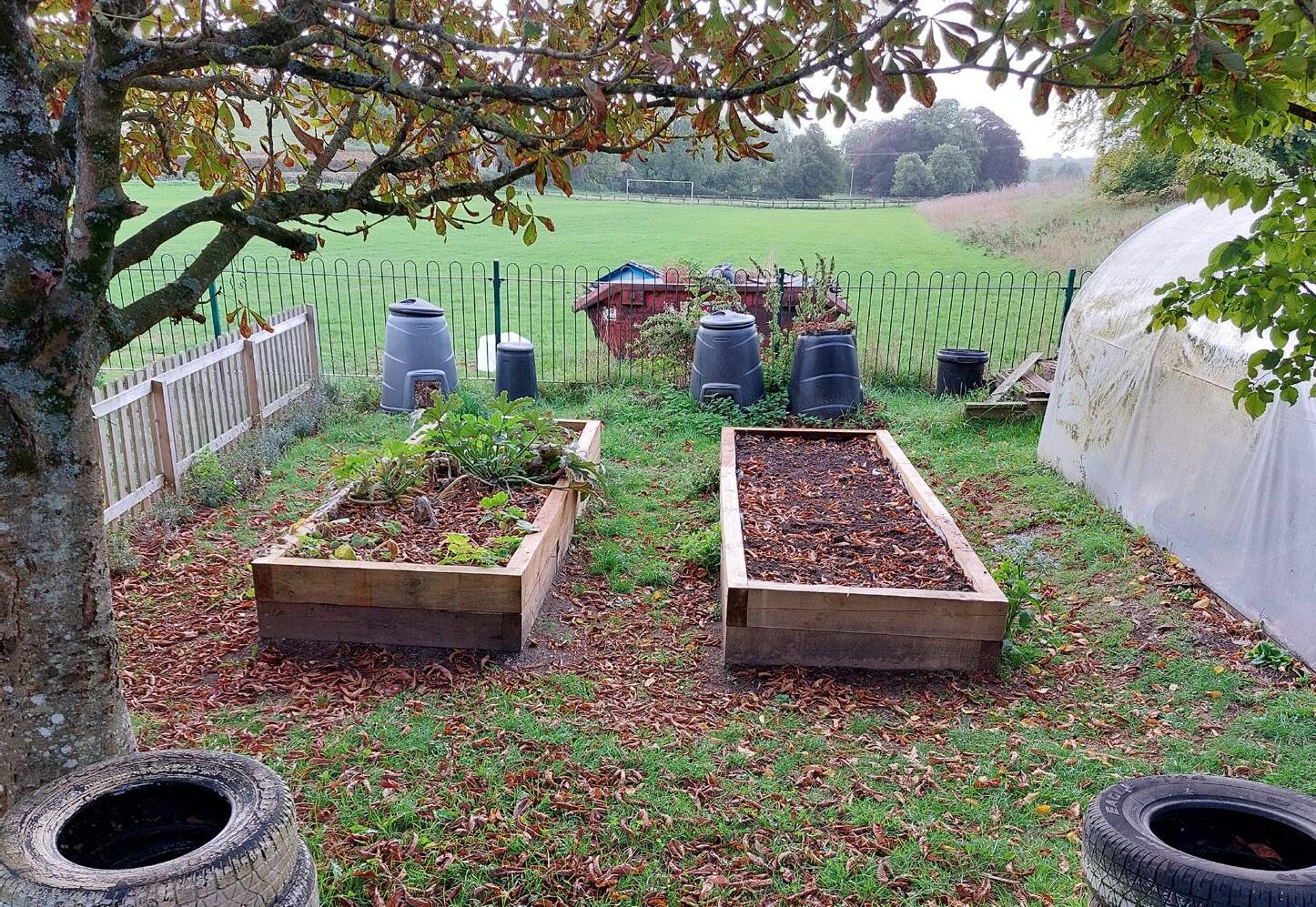
Open Evening is a special night for any school. It’s an opportunity for prospective students to take a peek at their future, and for our current cohort to showcase their skills and passions, both academic and extra-curricular.
This year, on Thursday 22nd of
September, this was no different for The Blandford School (TBS).
With a great turnout and plenty on display, we hope that Year 5 and Year 6 students, along with their families, had an enjoyable, insightful evening – and will choose us as their future secondary school.
‘I was delighted at the number of potential parents/carers present. Our admission numbers are very healthy and we are currently oversubscribed, so I encourage all parents/carers to apply as soon as possible!’ said Mrs Sally Wilson, Headteacher.
Sherborne Abbey played host to a magnificent evening celebrating student success as The Gryphon School held its annual prize giving ceremony for last year’s Year 11 and Year 13 students.

More than 100 students received awards during the evening, and the Abbey was full to capacity as parents and family joined the students to celebrate their achievements.
The awards were presented by Colin Sinclair, CEO of the Sherborne Area Schools’ Trust, of which The Gryphon is a founding member. Students performed a number of musical interludes, including Josie W. who sang a solo, Holly M. who played a flute solo, and Esme E. on piano.
A huge range of achievements were recognised in the
ceremony, including awards for subjects, academic achievement, contribution to school life, and personal achievement where students have excelled despite difficult circumstances.
The Year 13 students have now left The Gryphon to take their next steps and Head of Sixth Form Paul O’Donnell said ‘It was fantastic to see all our amazing Year 13 students again - they performed utterly superbly in their A levels and BTECs and this was just a small way for us to say well done. It is fantastic to see students going on to such a wide variety of courses and locations at university, apprenticeships in really varied fields, or taking a gap year before progressing onto further study. The results were superb across the board, but the fact that so many students achieved straight A* and A grades
was unprecedented. Aidan Hoggan, Bella Whitmore, Lucy Jones, Oliver Barrett and Katie Copp even went a stage further and achieved three A* grades. All our Year 13s have been a credit to the school and I look forward to hearing about their many successes in the future’.
Headteacher Nicki Edwards said ‘Our annual prize giving is a true celebration of our Gryphon ethos of living life in all its fullness. The atmosphere in the Abbey is so special, and we were delighted that so many students joined us as we recognised their academic achievements and personal progress. We would like to thank Sherborne Abbey for their support in delivering this truly memorable event for our students.’
Parents, carers and children really pulled out the stops and gathered an amazing array of harvest fresh produce, pasta, rice, tinned food and toiletries in a collection for Stower Provost Primary School’s harvest festival. Fresh produce was boxed up and raffled, while dried, tinned food and toiletries were all donated to the Gillingham Food Bank. ‘Our afternoon of celebrations included a gathering to recognise the MacMillan Coffee Morning events running nationwide –however ours was an ‘afternoon
cuppa’ instead!’ said headteacher Ailsa Boardman-Hirst. ‘This was followed by a special harvest

assembly including, songs, poems and stories all linked to harvest and amazing food facts.’


On Friday the 16th of September, Whitesheet CofE Primary had a whole-school trip to Longleat for a day. There were so many fantastic animals that we saw. At the start, we went on a boat where we got to see sea lions, monkeys, gorillas and hippos. It was so exciting seeing the hippos as they are normally under the water. Barking loudly, the sea lions were clamouring for attention. After the boat, we split off into our groups and went to see different and spectacular animals. My favourite part of the trip was seeing the sloths move and eat. They were twotoed sloths and I was ecstatic that I could see the sloths. Also we went through the safari and we saw all kinds of phenomenal creatures such as tigers, lions, giraffes, flamingos, rhinos and camels. We all had such a magnificent and wonderful experience at Longleat!
Written by 10 year old Hollie S in Year 6
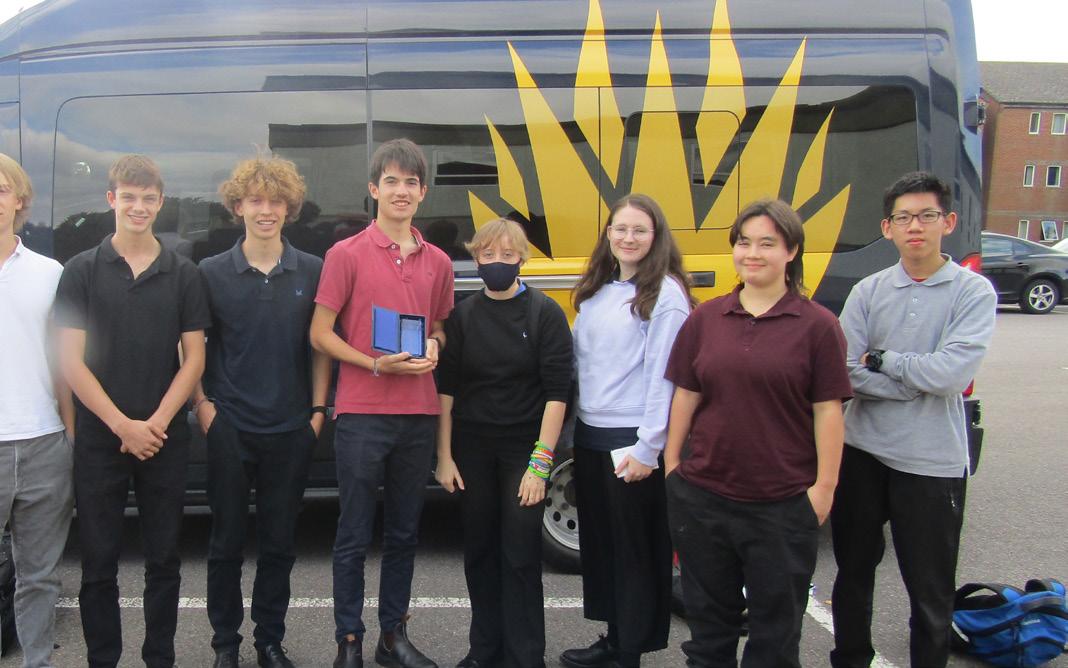
Nine GCSE Computer Science pupils from Bryanston School took part in the Army STEM Cyber Challenge run by the 11th (Royal School of Signals) Signal Regiment at Blandford Camp at the end of September.
The pupils completed activities including opensource intelligence gathering, Wi-Fi password cracking, deploying exploits to gain control of remote computers and using military tracking systems.
In the afternoon, pupils competed against schools from Dorset, Wiltshire and Hampshire in an escape room style challenge involving code breaking, accessing a locked laptop and gaining control of a wireless router.
Bryanston fielded two teams in a close-run contest against the clock. Jade B, Will J, Joe S-H, Jack W and Steven Z set a blistering pace, but in a late charge Harry B, Christabel C-J, Helena G and Angus M came in just a couple of minutes ahead, giving Bryanston first and second place overall. Well done to everyone that took part!
On Tuesday 13th September, Leweston Prep celebrated Roald Dahl Day; commemorating the author and his achievements. Each year group celebrated Dahl in their own way.
Reception made ‘Mr Twit’ beards complete with straw for the beard, cornflakes, crushed Shredded Wheat, feathers and cut out sardines, inspired from Mrs Cheyne’s favourite Roald Dahl book, ‘The Twits’.

Prep One were introduced to the story of ‘George’s Marvellous Medicine’. The pupils listened to the beginning of the story and spoke about the events. They then explored the classroom and came across some strange-looking ingredients and came up with their own recipe.
Prep Two got creative in the kitchen, making their own ‘Bruce Bogtrotter’ chocolate cake, from ‘Matilda’. Prep Three had a special lesson focusing on ‘George’s Marvellous Medicine’. The pupils were challenged to create their own ‘marvellous medicine’. They dreamt up some extremely imaginative ingredients, wrote careful instructions on how to make their potion and gave it a name.
Prep Four celebrated by illustrating drinks cartons in the style of Quentin Blake and adding our own Dahl-ian made up words! Prep Five started the day
by heading to the library and went on a book hunt for all of Roald Dahls books. Then in the afternoon the pupils focused on the illustrator of the Roald Dahl books ‘Quentin Blake’ and identified his style of drawing . They then created self-portraits in the same style.
Prep Six shared information they had researched about the author, and used this to create a fact file. There were some fantastic facts and some wonderfully presented fact files!

Sunninghill Prep School in Dorchester is celebrating the start of an exciting new era under the Headship of David Newberry.
David joined the school at the start of the Autumn Term and brings a wealth of experience – originally a Dorset man, David grew up on Portland before moving to London in his early twenties.
David said of his new appointment, ‘The minute I set foot in the school I felt the warmth from pupils and staff and knew this was where I wanted to be. Dorchester is an area that I know and love, and I am thrilled to have ‘come home’.
‘I want our pupils to pursue excellence and follow their passions both in the classroom and beyond. This can be achieved alongside the adventurous spirit that the school is renowned for. Our extracurricular activities, such as sailing and windsurfing with our partners at the Weymouth and Portland National Sailing Academy, really stretch and challenge our pupils in a safe environment.
‘I’m also placing creativity at the heart of our curriculum as it’s so important for our pupils’ personal growth and academic development.
‘When I’m asked what I want of our pupils, I always answer that I want them to be grounded but with a sense of adventure. I want them to be creative and able to adapt to our ever-changing world. I want them to be good citizens who know how to look after themselves and others. Our staff are proud to be part of the Sunninghill team and of the positive impact they have within our school and our wider community.’
Sunninghill’s Chair of Governors, Jean Walker, said that David Newberry’s ethos and values are well suited to Sunninghill Prep’s most senior role; ‘David places the pupils at the centre of every decision. His experience, ability to inspire pupils, parents and staff and his ambitious vision for our school makes

him the ideal person to lead us.’ David concluded by saying, ‘I would love the opportunity to show you what’s behind our Dorchester walls! Not only will you find some impressive learning and well-behaved children, but we also have beautiful grounds, an outdoor heated pool, a low ropes course, forest school, an all-weather sports pitch and so much more. If you would like to know more about us, please phone us or make contact via email. We would be delighted to welcome you to see our lovely school.’
If you could wave a magic wand and create the perfect pre-prep for little ones, how would it look?
The school would be designed to make those first steps on the learning journey packed full of wonder, excitement, challenge, and variety.
Inside, there’d be purpose-built spaces, some cosy, some high tech.
Outside, children would have the space to explore, learn, relax – or just let off steam.
And the staff, of course, would have the expert knowledge, enthusiasm, and – just as important –understanding of what makes younger pupils tick, knowing when to challenge them to go that little bit further and when to hold back.
The Walled Gardens’ Head, Polly Holbrook, says that this stage is all about giving children skills for the future: ‘It’s about the skill sets they need, about emotional intelligence, working as a group, creativity, adaptability, and having a growth mindset. All those skills are more important than ever,’ Polly explains. ‘We’re equipping them with skills, so that if something unexpected comes along, they’re not going to be knocked sideways. They’re going to be all right, cope, and be successful.’
To find out more about Sandroyd’s nursery and pre-prep The Walled Garden please visit www.sandroyd.org/Pre-Prep/The-Very-Best-Start/


September finally saw the completion of the ‘Man vs ...’ trilogy. The first of the trilogy, Man vs Coast. was completed back in 2019. Last year you may remember I wrote an article about my epic two-day 60 mile adventure running around the lakes (Man vs Lakes).
At the beginning of September
I made my way to Snowdonia to conquer Man vs Mountain, finally completing the trilogy after two years of deferrals and cancellations due to the pandemic.
To say I was ready for it would be ... incorrect. In fact, half way up the mountain I instantly regretted not training enough!
I always knew that 5,000ft of elevation across 22 miles of tough terrain, this was never going to be an easy race.
But six months post ankle break? Probably crazy, I hear you say. Trust me when I say that the views were honestly worth every single step.
This epic mountain adventure started at sea level from the stunning Caernarfon Castle, with not a mountain in sight.
A few miles in, the beautiful mountains of the Snowdonia National Park came into view and
the ascent up the Rangers path to the summit of Snowdon began. I made the summit and breathed a massive sigh of relief – and had a little sit down.
The view from the top I took a moment to appreciate my surroundings – how could you not? We were so lucky with a beautifully clear day. After such a gruelling climb I definitely appreciated the ease of the descent down the Llanberis path. Although, saying that, there were a few hairy moments on
the loose shale. The village of Llanberis was a welcome sight, but just when I thought I was done with the hills I reached the infamous ‘vertical kilometre’ up Dinorwic Quarry.
A few swear words might have slipped out at this point!
In true Rat Race fashion, the race ended in an array of different obstacles. It’s traditional, and this time included a bit of kayaking and a refreshing dip in Llyn Padarn before crossing the finish line, to receive the medal for the last segment of the trilogy.

Since the sad passing of Her Majesty the Queen, many stories have been shared about her and the ways in which she conducted her selfless duty and service to her people. Occasionally we also read anecdotes about her diet and lifestyle. While undoubtedly she had the very best of medical care during her reign, she was fit and active up until very recently. One thing that really stood out was her mental sharpness, right up until the end.
I’m 60 next month and naturally have developed a keen interest in the science of ageing and longevity! There are 15 million people in the UK over the age of 60, with major health issues beginning to kick in at the age of 65 – and it seems to be getting earlier for many. In the UK we are used to getting
‘free’ healthcare via the NHS.
Our medical system is excellent –especially for acute care – but it is not tailored to chronic illness. There has never been a better time to take your health into your own hands. Don’t wait to develop a problem – prevention is the cheapest strategy and it is never too late to start. Great nutrition and lifestyle habits are the cornerstone.
It is becoming better understood that cognitive decline may be preventable. Only one in 100 cases of dementia is gene-related – at least half of the risk factors are related to sugar intake, B vitamin status, coffee/ tea intake, fitness level, social interaction, intake of oily fish, antioxidants and blood pressure.
If you have not already heard it before, dementia and Alzheimer’s have been dubbed ‘diabetes Type 3’. In fact, Type 2 diabetes doubles the risk of dementia. While this highlights the importance of a low sugar way of eating, there are other important factors. Homocysteine is a common amino acid, which we mostly get from eating meat. For good brain health, the levels need to be below 10 and ideally 7mmol/l (millimoles per litre. A mole is a scientific unit often used to measure chemicals). Homocysteine is largely influenced by diet, mainly B vitamins and omega-3 fat intake. Lowering homocysteine levels has significantly reduced brain shrinkage and improved memory in those with early stages of dementia. Vitamin D status is also important as it is neuroprotective (helps prevent cell death)

Eating well and exercising are now known to be the key to good health as we age, says nutritional therapist Karen Geary
Don’t wait to develop a problem – prevention is the cheapest strategy
What to do: Go to foodforthebrain.org/thecognitive-function-test/ and take the free test to assess your risk and what to do about it. A longer version of my take on brain health is available on my website.
Arthritic aches and pains become more common with age – women in particular are frequently diagnosed with osteoporosis or osteopenia. Lack of movement is the main driver that puts stress on the joints.
What to do: Eat a largely antiinflammatory diet containing foods such as turmeric, quercetin (find it in onions and apples), plenty of purple and dark green foods and Omega-3 rich foods (including oily fish, chia seeds and walnuts). For some, reducing dairy can help reduce aches and pains, but increase dark leafy greens for calcium intake.
Exercise – both cardio and resistance/strength training, even just walking. Keep moving! Get your vitamin D levels up to 75-100nano mol/l as it is needed for strong bones and muscles. In winter it is probably necessary to take a supplement as it is hard to get from sunlight and foods alone. To find out your vitamin D status, you can do an at-home test here www.vitamindtest.org.uk/.
This deserves a separate article, so I will stick to the thorny topic of cholesterol. There are conflicting schools of thought on cholesterol and what defines ‘good’ and ‘bad’. What causes problems is when LDL (lowdensity lipoprotein, sometimes called ‘bad’ cholesterol, which makes up most of your body’s cholesterol) is glycosylated – and
crucially, not all LDL behaves that way. The glycosylated LDL accumulates where arteries have been damaged by high homocysteine.
What to do: Follow an antiinflammatory Mediterranean diet. Keep your blood sugar under control and your homocysteine levels low (tests are available online or through a registered nutritionist). Eat oily fish three times a week in order to keep triglyceride levels low, as we know that low triglycerides reduce heart disease risk.

Extra virgin olive oil has beneficial polyphenols and two tablespoons a day may help to increase HDL (high-density lipoprotein, or ‘good’ cholesterol – it absorbs cholesterol and carries it back to the liver), which exerts a protective effect against heart disease. Exercise also lowers blood pressure, which in turn reduces stroke risk.
A new study suggests that people are developing cancers earlier in life. Researchers cited significant changes in lifestyle and environment as possible factors. Eight of the 14 cancer types studied were related to the GI (gastrointestinal) tract, emphasising the importance of the microbiome when it comes to cancers. Diet directly affects the make-up of our gut and, over time, can influence the onset of disease. The study highlights the importance of consuming whole and unprocessed foods for the very best of gut health.
What to do: Eat all of the colours of the rainbow (a widely diverse diet of plants), fermented foods such as kefir, sauerkraut, kimchi, kombucha, and whole grains.
The gut loves diversity.
Diet directly affects the makeup of our gut and, over time, can influence the onset of disease
World Mental Health Day (WMHD) is fast approaching – 10th October. As a community, we have experienced significant change and loss over the course of the pandemic; I’ll be taking this time to reflect and acknowledge how I’m feeling – and try to be mindful of others.
The importance of mental health cannot be overstated. Being mentally healthy means being able to cope with feelings. It includes our emotional, psychological, and social wellbeing –affecting how we think, feel and act. I know when my mental health isn’t great, I feel increased pressure on my relationships.

It’s important to remember that everyone and anyone can experience poor mental health at some point in their lives. But some people might be more vulnerable then others, including people who identify as LGBTQI+, young people (of whom I am one), minority cultures and other marginalised communities.
While completing my final year at university last year, just after the Covid lockdowns, I felt isolated in grief. Living alone in a flat with the remnants of my flatmate’s belongings (she had returned to her home country), I sank into a period of depression. I sought help from my university to manage my workload and I attended weekly therapy sessions.
Post-lockdown I was able to join a university society, and I noticed a significant improvement in my mental health. I am in a much happier place now, but I find memories still trigger an emotional response. I continue to manage anxious thoughts and seek support for my own mental health. We should acknowledge the lasting impact the pandemic has had on our communities. World Mental Health Day is an opportunity to recognise other people’s feelings and to display kindness, reaching out to those in need.
We tend to ask people if they are OK without
allowing the space for a response beyond ‘I’m OK.’ Perhaps it’s the British in us – assuming we would burden others with our problems. If you sense someone isn’t feeling ‘fine’, enquire about it in a safe and private space which gives them the opportunity to reach out. Listening is key in supporting someone who may be experiencing mental health challenges.
Dorset Mind trainers reiterate the importance of listening, showing engagement through positive body language, maintaining eye contact to let others know you are interested in their replies – or by using affirmative movement such as nodding your head to show empathy. Remember to always ask twice to check they are OK.
Prioritise your own mental health by taking time for self-reflection; consider how you are feeling today and do more activities which bring you joy. You can also utilise this time to connect with others, through groups like Active in Mind or Wellbeing in Mind. Alternatively, Facebook is a helpful tool for discovering communities with common interests. Participants who have attended group support at Dorset Mind have shared the importance of being able to interact with others during a difficult period in their life.
On World Mental Health Day, 10th October, we want to #GetDorsetTalking about mental health and wellbeing. Our collective superpower as humans is our ability to feel and display empathy, listening and accepting others. You are only ever one conversation away from the help you deserve.
Dorset Mind have 1-2-1 and group support that you can access via their website: dorsetmind.uk/help-and-support/

The times they are uncertain, says CEO Ian Girling, as he looks to the new government to bring forward a considered and sustainable plan
Hello and a warm welcome to my October column – I’m hoping this finds you well. As I write this column, I’m reflecting on what unpredictable and strange times we are living in. We’ve seen Boris leave No 10 and just two days after Liz Truss met the Queen to agree to form a new Government, Her Majesty passed away. Prince Charles is now King Charles III. While the passing of the Queen was – and remains – incredibly sad, we marked her funeral and the King coming to the throne with magnificent ceremony. I am sure we will never see again. Since announcing the referendum in 2016, we have left the European Union, have had four Prime Ministers, experienced a global pandemic, witnessed Russia invade Ukraine and seen the passing
of our Queen after 70 years on the throne. It has, and continues to be, a unique period of uncertainty – and a very challenging time for businesses.
We continue to see rocketing energy prices (although the sixmonth price cap will offer some relief), soaring inflation, rising interest rates and a general cost of living crisis. The new Government came charging off the start line with the mini budget on 23rd September with a radical and bold range of new policies designed to inject confidence and growth into the economy.
Since then, we’ve seen a U-turn on the plan to cut the 45p tax rate for those earning more than £150,000 – just a day after Liz Truss pledged the Government
would stick with this policy. We’ve also seen the value of the pound plummet following the mini budget, and today’s news is that Liz Truss is facing mounting anger from within her own party over her refusal to commit to increasing benefits in line with inflation.
Our response to the budget was positive – but cautiously so. We were pleased to see the reversal of plans to increase corporation tax and national insurance, something the British Chambers of Commerce have been very vocal on.

We recognise that the Government clearly needs to act in response to the very challenging economic climate but it’s vital that we have a wellconsidered and sustainable plan for economic recovery.


The Cream Awards - Dairy Industry Trade Awards - is the premier event for UK dairy farmers. Organised by British Dairying magazine the annual event showcases some of the brightest and best people, businesses and innovations the industry has to offer. It demonstrates what the UK dairy industry can and is achieving, and its winners are ambassadors for the industry, showing leadership and innovation at a time when this is most needed.
The much-coveted Taste of Excellence award was sponsored by Morrisons Supermarkets, and Meggy Moo’s Dairy scooped the winner’s trophy for their Sea Salted Butter.
Judges comments were: ‘Won by unanimous vote from the judging panel.
‘Brilliantly balanced butter, presented well in the packaging,
with a wonderful rich flavour.’
Morrisons commented: ‘Meggy Moo’s sea salted butter is up there with some of the best butters we’ve tasted in our kitchen - well done.’
Shroton-based farmers Rachael and Alan Perrett started their farm’s direct sales business in 2016, after the birth of their first daughter, Megan, was born
(Meggy Moo’s is named after her). They and their robot-milking herd featured in the January issue of the BV.
‘We are thrilled and very proud to win this prestigious award for our Sea Salted Butter’ says Rachael.
‘Every product we produce is very much a team effort, so this is credit to the hard work put in by everyone at our farm.’

You are recruiting, have identified potential new employees and invited them to come for an interview. The interview is the opportunity for you to both find out more about each other. As an employer you will be aiming to find out more about the person; their skills, attitudes and behaviours, and whether they are right for your business. But remember the candidate will also be assessing you and your business and whether it is right for them!
Dorset Growth Hub are offering a free workshop in October – join Debbie Greenwood to find out all about interviewing the right way. The session will look at planning an interview - and also at the legal compliance that you need to be aware of.
Subjects to be covered include:
• Planning an interview.
• Identifying key skills and behaviours to rate candidates.
• Setting questions to prompt responses to identify the right candidate.
• Rating candidates fairly. Unconscious Bias.
• Putting candidates at their ease.
• Legal considerations when
hiring and interviewing including receiving and storing information.
• Employment rights, when and how do they kick in and how long are applicants protected.
Wednesday 19th October, 09:30 to 12 noon, at The Exchange in Sturminster Newton. FREE event, but registrations online here.
Dorset businesses are being offered a free course to gets to grips with new Environmental, Social and Governance (ESG) demands.
Dorset Chamber is running the free programme – called The Business Case for ESG – over the next six months, with the online workshops open to all firms countywide.
Industry experts will offer workshops on subjects ranging from energy efficiency, carbon footprints and offsetting, renewable energy to employee wellbeing and community and voluntary sector links. They will also feature details about support available from Low Carbon Dorset.
Dorset Chamber chief executive Ian Girling said: ‘ESG remains a
mystery for some in business but it is becoming increasingly important and difficult to ignore.
‘Essentially it is a set of principles by which a business’s accountability and transparency as well as its impact on society and the environment is measured.
‘Investors, existing and potential employees, customers and contractors are become more socially, ethically and environmentally aware, so businesses need to increasingly demonstrate their commitment to the principles of ESG.
‘Our new programme aims to bust some myths surrounding ESG, provide practical advice and show the very real benefits it can bring.’
Ian added: ‘we’re keen to see as
many businesses as possible take advantage of these free sessions.’ The launch event – An
Introduction to ESG – is on October 20 with ESG champion Gary Neild, chief executive of Blue Sky Financial Planning, and Phoebe Stone, head of sustainable investing at LGT Vestra LLP.
It will also feature from Dr Matt Montgomery, head of climate action at BCP Council and Dr Steven Ford, corporate director for climate and ecological sustainability at Dorset Council. Businesses can attend all of the sessions or choose which ones are of most interest.
Places for each session can also be booked on the chamber website at dorsetchamber.co.uk/ the-business-case-for-esg/.
Cyber resilience centres (CRC) are a national policing network - essentially they are crime prevention businesses for our digital age. They are led by serving police officers and staff, and thanks to Home Office funding they are able to provide a swathe of free guidance and support to businesses, charities and the public sector.
A core part of their work is helping small businesses learn online skills and cyber basics. They can provide a health check on your IT system security
through to assisting on how to recover from a cyber attack –which happens more often than most would think. Two in five businesses spotted an attempted cyber breach last year; their offer is an essential one for most small businesses.

Each cyber resilience centre has enjoys building strong business partnerships, and they are keen to do whatever they can to work more widely with the business community.
The CRC’s want to work with as many small businesses and
charities as they can, in order to make the entire local community safer (potentially when a local business is under cyber attack, the data they hold is also threatened, and in small local businesses that data is the local community).
They are also keen to speak with bigger companies who might be able to provide support in turn. You can find contact details for Dorset’s CRC at swcrc.co.uk.
They’ll be very happy to talk with you and to explore the potential for mutual support.













